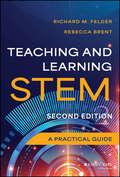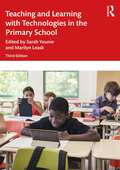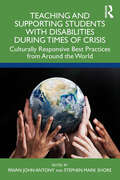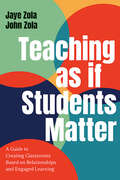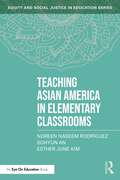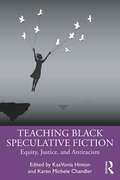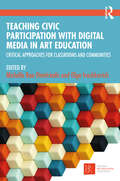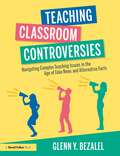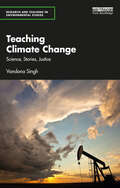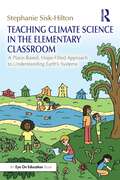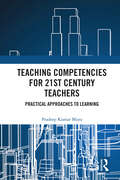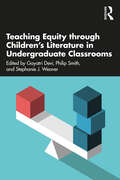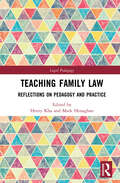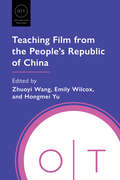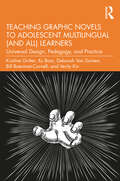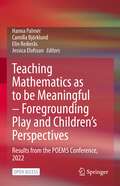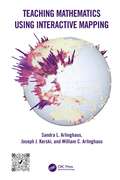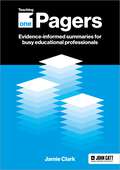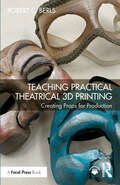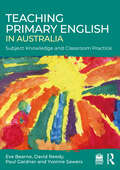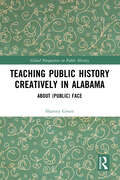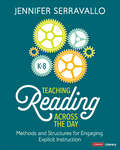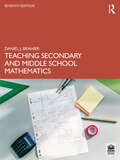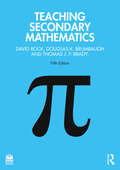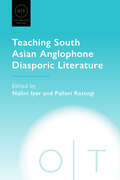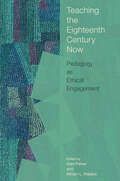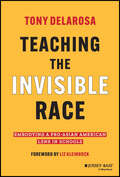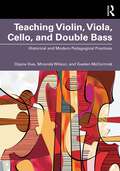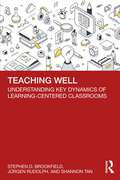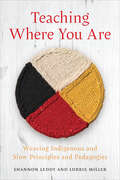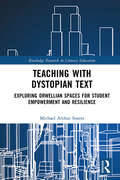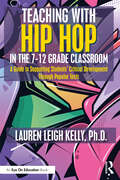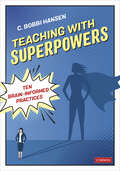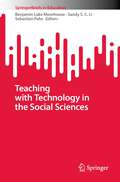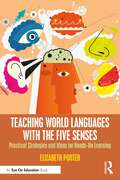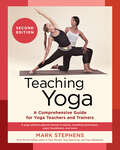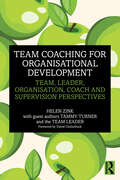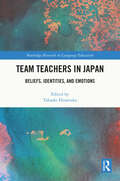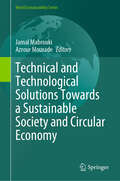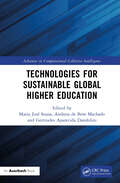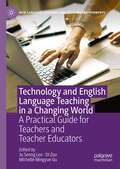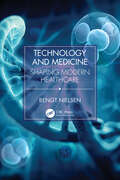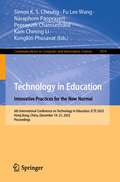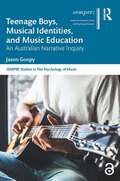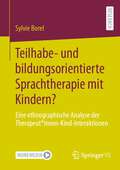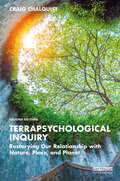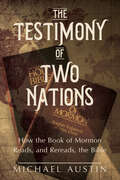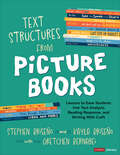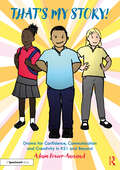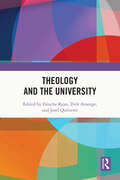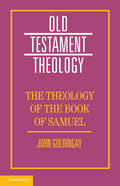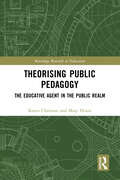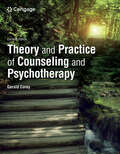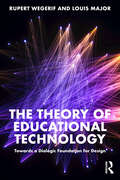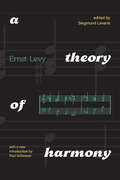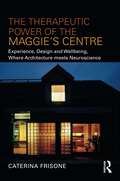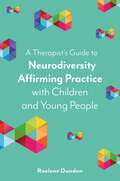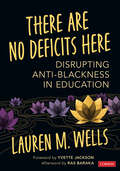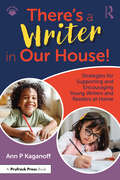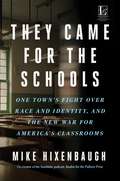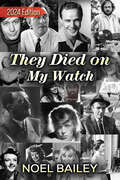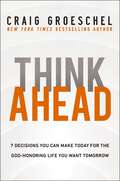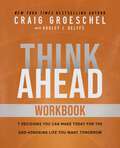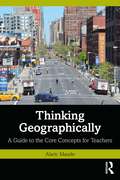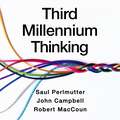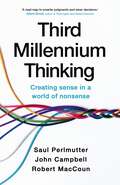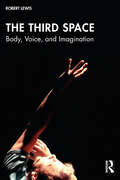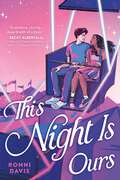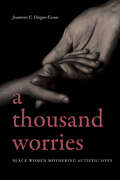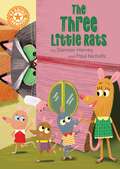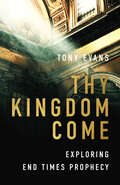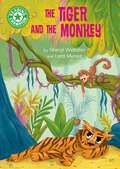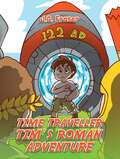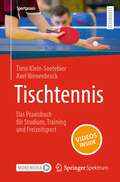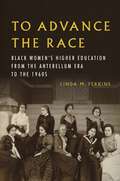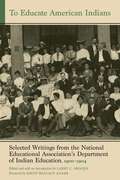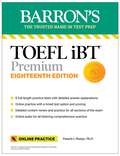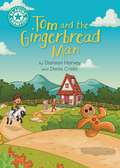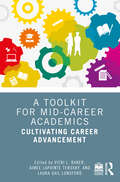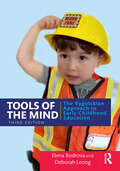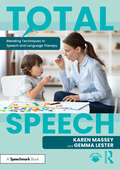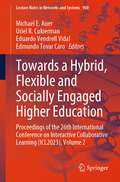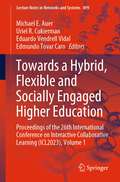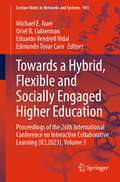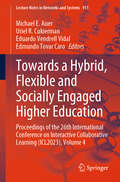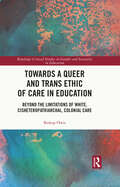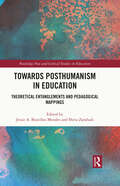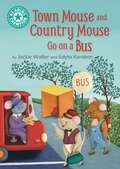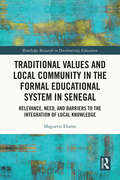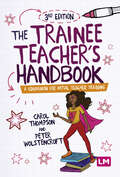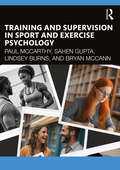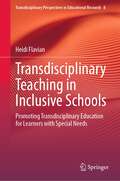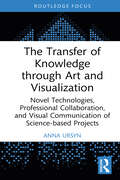- Table View
- List View
Teaching and Learning STEM: A Practical Guide
by Richard M. Felder Rebecca BrentThe widely used STEM education book, updated Teaching and Learning STEM: A Practical Guide covers teaching and learning issues unique to teaching in the science, technology, engineering, and math (STEM) disciplines. Secondary and postsecondary instructors in STEM areas need to master specific skills, such as teaching problem-solving, which are not regularly addressed in other teaching and learning books. This book fills the gap, addressing, topics like learning objectives, course design, choosing a text, effective instruction, active learning, teaching with technology, and assessment—all from a STEM perspective. You’ll also gain the knowledge to implement learner-centered instruction, which has been shown to improve learning outcomes across disciplines. For this edition, chapters have been updated to reflect recent cognitive science and empirical educational research findings that inform STEM pedagogy. You’ll also find a new section on actively engaging students in synchronous and asynchronous online courses, and content has been substantially revised to reflect recent developments in instructional technology and online course development and delivery. Plan and deliver lessons that actively engage students—in person or online Assess students’ progress and help ensure retention of all concepts learned Help students develop skills in problem-solving, self-directed learning, critical thinking, teamwork, and communication Meet the learning needs of STEM students with diverse backgrounds and identitiesThe strategies presented in Teaching and Learning STEM don’t require revolutionary time-intensive changes in your teaching, but rather a gradual integration of traditional and new methods. The result will be a marked improvement in your teaching and your students’ learning.
Teaching and Learning with Technologies in the Primary School
by Marilyn Leask Sarah YounieThis fully updated third edition of Teaching and Learning with Technologies in the Primary School introduces practising and student teachers to the range of ways in which technology can be used to support and extend teaching and learning opportunities in their classrooms.Newly expanded to include 50% brand new chapters reflecting the abundant changes in the field since the last edition was published, it offers practical guidance underpinned by the latest research and teaching in the field. The authors draw on the extensive experience of educators in Australia, England, Ireland, Scotland, South Africa, the U.S.A. and Wales to provide local, national and international examples of the application of digital technologies to teaching and learning across the primary curriculum.Illustrated throughout with case studies and examples together with a glossary explaining key terms, chapters focus on how technology-based practices can support the teaching of individual subjects, as well as a range of teaching and learning styles. Key and new topics covered include:- Supporting reading and writing with technology- Technology in the early years- Developing e-skills of parents- Use of Virtual Reality in learning- PedTech- Resilience in the digital worldWritten for all training primary teachers, as well as more experienced teachers and technology co-ordinators looking for guidance on the latest innovative practice, Teaching and Learning with Technologies in the Primary School, 3rd edition, offers advice and ideas for creative, engaging and successful teaching and learning.
Teaching and Supporting Students with Disabilities During Times of Crisis: Culturally Responsive Best Practices from Around the World
by Pavan John Antony Stephen Mark ShoreThis volume offers international perspectives on the disproportionate impact COVID-19 has had on disabled students and their families, serving as a call to action for educational systems and education policy to become proactive, rather than reactive, for future disasters. Each chapter in the book is written by authors with lived experiences across diverse global regions, highlighting the daily life of people with disabilities and their families during the pandemic. Including case studies and practical suggestions, the book demonstrates that culturally responsive practices are essential to successfully support people around the world in their times of need. At the critical intersection of education and disability human rights, this book is important for pre-service teachers, researchers, professors, and graduate students to ensure all students are supported during times of crisis.
Teaching as if Students Matter: A Guide to Creating Classrooms Based on Relationships and Engaged Learning
by Jaye Zola John ZolaTeaching as if Students Matter supports the goal of new teachers to create engaging classrooms where students want to learn. It provides concrete and specific methods for building relationships with all students, managing their behaviors in positive ways, and planning for engaged and authentic instruction. Throughout, the book emphasizes the critical role of culturally responsive teachers in creating inclusive curriculum and meaningful relationships to help all students learn and succeed. This book provides specific advice on how to build a classroom culture where discussion can flourish, as well as ideas for working with colleagues, and maintaining a healthy work-life balance. As one reviewer wrote "after reading this book, I really […] believe I can do this!"
Teaching Asian America in Elementary Classrooms (Equity and Social Justice in Education Series)
by Noreen Naseem Rodríguez Soyhun An Esther June KimAsian American voices and experiences are largely absent from elementary curricula. Asian Americans are an extraordinarily diverse group of people, yet are often viewed through stereotypical lenses: as Chinese or Japanese only, as recent immigrants who do not speak English, as exotic foreigners, or as a “model minority” who do well in school. This fundamental misperception of who Asian Americans are begins with young learners―often from what they learn, or do not learn, in school. This book sets out to amend the superficial treatment of Asian American histories in U.S. textbooks and curriculum by providing elementary teachers with a more nuanced, thematically driven account. In chapters focusing on the complexity of Asian American identity, major moments in Asian immigration, war and displacement, issues of citizenship, and Asian American activism, the authors include suggestions across content areas for guided class discussions, ideas for broader units, and recommendations for children’s literature as well as primary sources.
Teaching Black Speculative Fiction: Equity, Justice, and Antiracism
by KaaVonia Hinton Karen Michele ChandlerTeaching Black Speculative Fiction: Equity, Justice, and Antiracism edited by KaaVonia Hinton and Karen Michele Chandler offers innovative approaches to teaching Black speculative fiction (e.g., science fiction, fantasy, horror) in ways that will inspire middle and high school students to think, talk, and write about issues of equity, justice, and antiracism. The book highlights texts by seminal authors such as Octavia E. Butler and influential and emerging authors, including Nnedi Okorafor, Kacen Callender, B. B. Alston, Tomi Adeyemi, and Bethany C. Morrow.Each chapter in Teaching Black Speculative Fiction: introduces a Black speculative text and its author, describes how the text engages with issues of equity, justice, and/or antiracism, explains and describes how one theory or approach helps elucidate the key text’s concern with equity, justice, and/or antiracism, and offers engaging teaching activities that encourage students to read the focal text; that facilitate exploration of the text and a theoretical lens or critical approach; and that guide students to consider ways to extend the focus on equity, justice, and/or antiracism to action in their own lives and communities.
Teaching Civic Participation with Digital Media in Art Education: Critical Approaches for Classrooms and Communities
by Michelle Bae-Dimitriadis Olga IvashkevichThis anthology shares educational practices to engage young people in critical digital media consumption and production. Comprehensive frameworks and teaching guidance enable educators to empower students to use digital technologies to respond to the social, political, economic, and other critical issues in their real-life and online communities. Section I of the book explores philosophical and conceptual approaches to teaching civic participation via digital media and technologies in various educational settings, Section II focuses on the participatory civic approaches in K-16 art education classrooms, and Section III outlines these approaches for arts-based community settings (after school programs, camps, online sites). Throughout, authors reference different technologies – video, digital collage, glitch, game design, mobile applications, virtual reality, and social media – and offer in-depth discussions of pedagogical processes and exemplary curriculum projects. Building on National (NAEA) and State Media Arts Standards, the educational practices outlined facilitate students’ media literacy skills and digital citizenship awareness in the art classroom and provide a solid foundation for teaching civic-minded media making. Ideal for art and media educators within preservice and higher education spaces, this book equips readers to prepare their students to be thoughtful and critical producers of their own media that can effectively advocate for social change.
Teaching Classroom Controversies: Navigating Complex Teaching Issues in the Age of Fake News and Alternative Facts
by Glenn Y. BezalelTeaching Classroom Controversies is the essential guide for all teachers trying to navigate their way through issues of controversy in the age of ‘fake news’ and ‘alternative facts’. Arguing that schools have a key role to help turn the tide and promote intellectual humility and openness, the book shows teachers how they can set the boundaries to ensure a purposeful learning environment that thinks about controversy in terms of evidence, reasoned argument, and critical reflection. Drawing on the latest research, the first part of the book provides frameworks for teaching and learning about controversy, including how to facilitate respectful discussion, the biases that impact student beliefs, and the pedagogical techniques that should be applied in the classroom. The second part offers practical guidance on how to teach the most contentious issues facing young children and teenagers in society today, dealing with wide-ranging questions such as: Is Santa Claus real? Do I have a ‘normal’ family? Is the Holocaust a hoax? Should there be any limits on free speech? Teaching Classroom Controversies offers teachers the tools to develop their students' critical thinking on the timely and cutting-edge issues of controversy that are shaping our world.
Teaching Climate Change: Science, Stories, Justice (Research and Teaching in Environmental Studies)
by Vandana SinghTeaching Climate Change: Science, Stories, Justice shows educators how climate change can be taught from any disciplinary perspective and in a transdisciplinary way, drawing on examples from the author's own classroom. The book sets out a radical vision for climate pedagogy, introducing an innovative framework in which the scientific essentials of climate change are scaffolded via three transdisciplinary meta-concepts: Balance/Imbalance, Critical Thresholds and Complex Interconnections. Author Vandana Singh grounds this theory in practice, drawing on examples from her own classroom to provide implementable ideas for educators, and to demonstrate how climate change can be taught from any disciplinary perspective in a transdisciplinary way. The book also explores the barriers to effective climate education at a macro level, focusing on issues such as climate misinformation/misconception, the exclusion of social and ethical concerns and a focus on technofixes. Singh uses this information to identify four key dimensions for an effective climate pedagogy, in which issues of justice are central: scientific-technological, the transdisciplinary, the epistemological and the psychosocial. This approach is broad and flexible enough to be adapted to different classrooms and contexts. Bridging the social and natural sciences, this book will be an essential resource for all climate change educators practicing in both formal and informal settings, as well as for community climate activists.
Teaching Climate Science in the Elementary Classroom: A Place-Based, Hope-Filled Approach to Understanding Earth’s Systems
by Stephanie Sisk-HiltonDiscover new ways to help elementary students engage with and understand the world around them through place-based, hope-filled learning about the causes, impacts, and responses to climate change. This book features foundational climate concepts, easily implementable activity plans, and inspiring examples of student engagement. Each chapter begins with a short vignette pulled from the author’s considerable teaching experience in engaging students in concepts of climate change and climate justice, followed by content-focused sections and recommendations for student activities and projects. The author provides stories of hope-filled action to invite teachers to look for and reflect on similar narratives in their own communities. Sample units of study for grades K-5 show teachers how key ideas from each chapter come together into an instructional plan that incorporates the three dimensions of NGSS and can fit into the broader outline of their school year. This resource is an accessible tool to support any elementary educator in building their own knowledge base and integrating the important and timely issues of climate change into their classroom.
Teaching Competencies for 21st Century Teachers: Practical Approaches to Learning
by Pradeep Kumar MisraA must-read for every teacher in the 21st Century, this book provides a comprehensive guide to facilitating joyful, sustainable, holistic, multidisciplinary, and active learning. The book discusses different approaches, principles, techniques, and activities for creating a classroom where different learning types can thrive. The methods outlined in this volume help teachers ensure that every learner, regardless of background or orientation, can engage in participatory, reflective, self-directed, experiential, entrepreneurial, and collaborative learning and develop holistically. Essential for the 21st century, the book highlights the significance of digital technologies and examines how teachers can easily use digital technologies to offer personalized and blended learning. This book is a vital resource for teachers who want to improve their teaching skills and create a positive and engaging learning environment for their learners. This book helps teachers across the globe to enhance learning outcomes in classrooms and, subsequently, develop the quality of their education systems. This volume is useful to students, researchers, and teachers in education, psychology, development studies, social work, and sociology. It is also an invaluable companion to policymakers and professionals from government and non-government organisations working in the education and social development sectors.
Teaching Equity through Children’s Literature in Undergraduate Classrooms
by Gayatri Devi Philip Smith Stephanie J. WeaverChildren's literature has been taught in undergraduate classrooms since the mid-1960s and has grown to become a staple of English literature, library science, and education programs. Children's literature classes are typically among the most popular course offerings at any institution. It is easy to understand why; children's literature classes promise students the opportunity to revisit familiar works with fresh eyes. With the growth of the children’s publishing industry and the celebration of recent scholarly interventions in the field, the popularity of the discipline is unlikely to abate. A central question of current children’s literature scholarship and practice is how to effectively address contemporary questions of social justice. This collection offers a series of interventions for the practice of teaching equity through children's literature in undergraduate classrooms. It is intended for individuals who teach, or who are interested in teaching, children’s literature to undergraduates. It includes contributions from practitioners from a range of institutional affiliations, disciplinary backgrounds, nationalities, and career stages. Furthermore, this volume includes contributions from scholars who belong to groups which are often underrepresented within academia, due to race, nationality, ethnicity, gender identity, disability, or other protected characteristics.
Teaching Family Law: Reflections on Pedagogy and Practice (Legal Pedagogy)
by Henry Kha and Mark HenaghanThis book provides a comprehensive analysis of the teaching of an eclectic range of family law topics and the unique opportunities and challenges of teaching family law in different jurisdictions from a varied international perspective. Written by leading legal scholars, the book addresses a gap in the scholarship to comprehensively and systematically analyse the teaching of family law. The first part of the book explores ways of teaching the varied range of topics under the heading of family law and captures the diverse approaches to the discipline. Chapters illustrate how the subject can be best taught in an interdisciplinary way that considers feminist perspectives and the philosophy of teaching, while encompassing legal positivism, empirical research and critical legal theory. The second part of the book examines teaching in different jurisdictions and illustrates policy and practice in Australia, New Zealand, the United States, Canada, the United Kingdom, Hong Kong and South Africa. Showcasing examples of best practice of teaching family law, the book will be an essential reading for legal scholars, as well as researchers and postgraduate students in the fields of family law and legal education.
Teaching Film from the People's Republic of China (Options for Teaching)
by Zhuoyi Wang, Emily Wilcox, and Hongmei YuThis volume brings a diverse range of voices--from anthropology, communication studies, ethnomusicology, film, history, literature, linguistics, sociology, theater, and urban geography--into the conversation about film from the People's Republic of China. Essays seek to answer what films can reveal or obscure about Chinese history and society and demonstrate how studying films from the PRC can introduce students to larger issues of historical consciousness and media representation.The volume addresses not only postsocialist fictional films but also a wide variety of other subjects including socialist period films, documentaries, films by or about people from ethnic minority groups, film music, the perspectives of female characters, martial arts cinema, and remakes of South Korean films. By exploring how films represent power, traditions, and ideologies, students learn about both the complexity of the PRC and the importance of cross-cultural and cross-ideological understanding.
Teaching Graphic Novels to Adolescent Multilingual (and All) Learners: Universal Design, Pedagogy, and Practice
by Kristine Gritter Xu Bian Deborah Van Duinen Bill Boerman-CornellThis book provides a roadmap for teaching with graphic novels as an effective and engaging approach to advancing reading comprehension for English Learners in secondary schools. Accessibly synthesizing and presenting existing graphic novel research, the authors walk through how to use graphic novels as a teaching tool to improve student motivation and key reading skills, increase their reading proficiency levels, and bolster their vocabulary. The authors provide curricular ideas for teaching multilingual, gifted, and striving readers, along with methods for developing critical literacy and multimodal comprehension. Applying a universal design approach and including examples, current graphic novel recommendations, and pedagogical strategies, this book is essential reading for pre-service teachers in TESOL and literacy education.
Teaching Mathematics as to be Meaningful – Foregrounding Play and Children’s Perspectives: Results from the POEM5 Conference, 2022
by Hanna Palmér Camilla Björklund Elin Reikerås Jessica ElofssonThis open access book’s theme is Teaching mathematics as to be meaningful – foregrounding children’s play and perspectives. It discusses the relation between teachers, children and mathematical content within the context of play with a particular focus on the framing of these relations within this context, which is an important theme in the debate on whether teaching should be integrated with or separated from children’s play. The work further addresses meaningfulness in the learning process, particularly from the child’s perspective. Globally, most guidelines and curricula for early childhood education mention play as one of the key features for young children’s learning. Still, there are quite different views on the definitions of play and in what ways play should become part of children’s learning. The chapters of the book mirror the research topics presented at the fifth POEM conference in May 2022 divided into four sub-themes: Play and learning, Children’s perspectives on mathematics, Teachers’ competencies and Theorizing aspects of early mathematics education.
Teaching Mathematics Using Interactive Mapping
by Sandra L. Arlinghaus Joseph J. Kerski William C. ArlinghausTeaching Mathematics Using Interactive Mapping offers novel ways to learn basic math topics such as simple relational measures or measuring hierarchies through customized interactive mapping activities. These activities focus on interactive web-based Geographic Information System (GIS) and are relevant to today’s problems and challenges. Written in a guided, hands-on, understandable manner, all activities are designed to build practical and problem-solving skills that rest on mathematical principles and move students from thinking about maps as references that focus solely on "where is" something, to analytical tools, focusing primarily on the "whys of where." Success with this transition through interaction permits most readers to master mathematical concepts and GIS tools. FEATURES Offers custom-designed geographical activities to fit with specific mathematical topics Helps students become comfortable using mathematics in a variety of professions Provides an innovative, engaging, and practical set of activities to ease readers through typically difficult, often elementary, mathematical topics: fractions, the distributive law, and much more Uses web-based GIS maps, apps, and other tools and data that can be accessed on any device, anywhere, at any time, requiring no prior GIS background Written by experienced teachers and researchers with lifelong experience in teaching mathematics, geography, and spatial analysis This textbook applies to undergraduate and graduate students in universities and community colleges including those in basic mathematics courses, as well as upper-level undergraduate and graduate students taking courses in geographic information systems, remote sensing, photogrammetry, geography, geodesy, information science, engineering, and geology. Professionals interested in learning techniques and technologies for collecting, analyzing, managing, processing, and visualizing geospatial datasets will also benefit from this book as they refresh their knowledge in mathematics.
Teaching One-Pagers: Evidence-informed summaries for busy educational professionals
by Jamie ClarkAsk any teacher and they would say workload is one of the biggest blockers to their professional development. Simply put, most teachers are time-poor and too busy to engage with educational research to improve their classroom instruction. One-pagers are ultra-concise, A4-sized summaries that share important ideas about good teaching. In this practical volume, Jamie Clark presents more than 55 evidence-informed one-pagers that help educators reflect on their practice, build pedagogical knowledge, and prompt professional conversations with colleagues.
Teaching Practical Theatrical 3D Printing: Creating Props for Production
by Robert C. BerlsTeaching Practical Theatrical 3D Printing: Creating Props for Production is a cohesive and practical guide for instructors teaching 3D printing techniques in stagecraft, costume and props courses.Written for the instructor, this book uses non-technical language to explain 3D printers, their workflows and products. Coverage includes the ins and outs of multiple filaments, pros and cons of different types of printers, shop or laboratory setup and safety concerns. The book features lesson plans, rubrics and class-tested sample student projects from design to finished product that highlight learning objectives and methodologies, as well as software and hardware usage explanations and common problems that can occur within design and printing. Step-by-step instructions are included for many types of projects, including fake noses, candlestick phones, buttons, 3D scans, historical recreations and linear actuators. The book also contains examples of poor, average and excellent work with grading explanations and guidance on how to help the student move to the next level with their projects. Chapter objectives, chapter summaries, checklists and reflection points facilitate an instructor in gaining confidence with 3D printers and incorporating their use in the classroom.Teaching Practical Theatrical 3D Printing is an excellent resource for instructors of Props and Costume Design and Construction courses that are interested in using state of the art tools and technology for theatre production.Fully editable files for every object featured in the book are available at www.routledge.com/9781032453279, allowing readers to jump-start their projects and giving them the flexibility to change and redesign the items to best fit their needs.
Teaching Primary English in Australia: Subject Knowledge and Classroom Practice
by Eve Bearne David Reedy Paul Gardner Yvonne SawersThis first Australian edition of Teaching Primary English has been updated and adapted to reflect the Australian sociocultural and educational context. This text provides a comprehensive, evidence informed introduction to teaching and learning English in the primary school classroom. New content refers to the Australian English Curriculum and incorporates Aboriginal and Torres Strait Islander perspectives and literacy perspectives relevant to the Asia-Pacific region as well as the broader international context. This edition also includes a new section devoted to visual literacy, critical literacy and multimodality. Teaching advice and ideas are supported by practical examples linked to video clips filmed in real schools, reflective activities, observational tasks and online resources. Each section includes suggestions for great children’s literature and offers assessment advice and support for planning for diversity and special educational needs. Drawing on the very latest research and theory, supported by practical examples and guidance, this is an essential resource for pre-service teachers as they develop subject knowledge and the skills and confidence to deliver effective and engaging classroom practice.
Teaching Public History Creatively in Alabama: About (Public) Face (Global Perspectives on Public History)
by Sharony GreenThis book chronicles a University of Alabama historian’s efforts to engage public history over the course of a decade, highlighting personal and educational experiences inside and outside of the classroom.Each chapter reveals how Sharony Green, her students, and collaborators used various public places and spaces in Alabama, including the University of Alabama and Tuscaloosa, where she teaches, as “labs” to learn more about our shared past. Inspired by her familiar beginnings in a historic community in Miami, Florida, the author, a descendant of people from the American South and the Bahamas, unveils her encounters with the built environment, old documents and objects, motion pictures, music, and all kinds of historical actors. The book shares a variety of projects including exhibits and displays, images, videos, songs, and poetry, that serve as manifestations of her encounters with the places around her and her students. Together, these stories uncover an unexpected journey into public history, offering new ways to think about the field and humanities more generally.Teaching Public History Creatively in Alabama is an enlightening resource to both intentional and unintentional practitioners of public history, including scholars, students, and general readers interested in connecting with the past.
Teaching Reading Across the Day, Grades K-8: Methods and Structures for Engaging, Explicit Instruction
by Jennifer Serravallo"Reading well across disciplines and within varied contexts will help students to be versatile, flexible, deep readers who can better learn from their reading, transfer skills across subjects, and use strategies to meet the unique demands of reading in each content area." – Jennifer Serravallo Research-based, easy-to-use lesson structures for explicit and engaging teaching In Teaching Reading Across the Day, literacy expert Jennifer Serravallo provides nine effective, predictable, research-based lesson structures that help busy teachers save planning time and focus their teaching—and student attention—on content rather than procedures. Each of the nine lesson structures (read aloud, phonics and spelling, vocabulary, focus, shared reading, close reading, guided inquiry, reader’s theater, and conversation) has its own chapter and features a wealth of resources that let you see the lessons in action in ELA, Science, and Social Studies classes, including: An annotated teaching vignette, lesson explanation, and research notes Tips for planning, structure and timing suggestions, and ideas for responsive teaching Detailed planning templates and 22 accompanying online videos covering over 3 hours of classroom footage Jen’s reflections, key look-fors, and ideas for next steps The nine lesson structures can be used with any curriculum or core program, text, and subject, making it easier for teachers to maximize explicit and engaging teaching time across the day, and simplify planning and preparation. Jen incorporates a wide range of compelling research about how best to teach reading to every student in your class and translates the research (or the science of teaching reading) into high-leverage moves you can count on to deliver powerful lessons again and again. She also honors the art of teaching reading, helping teachers tap into their experience and hone their expertise to make quick, effective classroom decisions that take student learning to the next level.
Teaching Reading Across the Day, Grades K-8: Methods and Structures for Engaging, Explicit Instruction
by Jennifer Serravallo"Reading well across disciplines and within varied contexts will help students to be versatile, flexible, deep readers who can better learn from their reading, transfer skills across subjects, and use strategies to meet the unique demands of reading in each content area." – Jennifer Serravallo Research-based, easy-to-use lesson structures for explicit and engaging teaching In Teaching Reading Across the Day, literacy expert Jennifer Serravallo provides nine effective, predictable, research-based lesson structures that help busy teachers save planning time and focus their teaching—and student attention—on content rather than procedures. Each of the nine lesson structures (read aloud, phonics and spelling, vocabulary, focus, shared reading, close reading, guided inquiry, reader’s theater, and conversation) has its own chapter and features a wealth of resources that let you see the lessons in action in ELA, Science, and Social Studies classes, including: An annotated teaching vignette, lesson explanation, and research notes Tips for planning, structure and timing suggestions, and ideas for responsive teaching Detailed planning templates and 22 accompanying online videos covering over 3 hours of classroom footage Jen’s reflections, key look-fors, and ideas for next steps The nine lesson structures can be used with any curriculum or core program, text, and subject, making it easier for teachers to maximize explicit and engaging teaching time across the day, and simplify planning and preparation. Jen incorporates a wide range of compelling research about how best to teach reading to every student in your class and translates the research (or the science of teaching reading) into high-leverage moves you can count on to deliver powerful lessons again and again. She also honors the art of teaching reading, helping teachers tap into their experience and hone their expertise to make quick, effective classroom decisions that take student learning to the next level.
Teaching Secondary and Middle School Mathematics
by Daniel J. BrahierTeaching Secondary and Middle School Mathematics combines the latest developments in research, technology, and standards with a vibrant writing style to help teachers prepare for the excitement and challenges of teaching secondary and middle school mathematics. The book explores the mathematics teaching profession by examining the processes of planning, teaching, and assessing student progress through practical examples and recommendations. Beginning with an examination of what it means to teach and learn mathematics, the reader is led through the essential components of teaching, concluding with an examination of how teachers continue with professional development throughout their careers. Hundreds of citations are used to support the ideas presented in the text, and specific websites and other resources are presented for future study by the reader. Classroom scenarios are presented to engage the reader in thinking through specific challenges that are common in mathematics classrooms. The seventh edition has been updated and expanded with particular emphasis on the latest technology, standards, and other resources. The reader is introduced to the ways that students think and how to best meet their needs through planning that involves attention to differentiation, as well as how to manage a classroom for success. Features include: • Following on from the sixth edition, assessment takes a central role in planning and teaching. Unit 3 (of 5) addresses the use of summative and formative assessments to inform classroom teaching practices. • A new appendix is included that lists websites that can be used in a methods class to view other teachers interacting with students for discussion of effective teaching practices. • The feature entitled “Links and Resources” has been updated in each of the 13 chapters. Five strongly recommended and practical resources are spotlighted at the end of each chapter as an easy reference to some of the most important materials on the topic. • Approximately 150 new citations have either replaced or been added to the text to reflect the latest in research, materials, and resources that support the teaching of mathematics. • Significant revisions have been made to Chapter 12, which now includes updated research and practices as well as a discussion on culturally responsive pedagogy. Likewise, Chapter 8 now includes a description of best and high-leverage teaching practices, and a discussion in Chapter 11 on alternative high school mathematics electives for students has been added. • Chapter 9, on the practical use of classroom technology, has again been revised to reflect the latest tools available to classroom teachers, including apps that can be run on handheld personal devices, in light of changes in education resulting from the global pandemic. An updated Instructor’s Manual features a test bank, sample classroom activities, PowerPoint slide content, chapter summaries, and learning outcomes for each chapter, and can be accessed by instructors online at www.routledge.com/9781032472867.
Teaching Secondary Mathematics
by David Rock Douglas K. Brumbaugh Thomas J. BradySolidly grounded in up-to-date research, theory, and technology, Teaching Secondary Mathematics is a practical, student-friendly, and popular text for secondary mathematics methods courses. It provides clear and useful approaches for mathematics teachers and shows how concepts typically found in a secondary mathematics curriculum can be taught in a positive and encouraging way. The thoroughly revised fifth edition combines this pragmatic approach with truly innovative and integrated technology content throughout. Synthesized content between the book and a comprehensive Instructor and Student Resource website offers expanded discussion of chapter topics, additional examples, and technological tips, such as using and assessing artificial intelligence.Each chapter features tried-and-tested pedagogical techniques, problem-solving challenges, discussion points, activities, mathematical challenges, and student-life-based applications that will encourage students to think and do.New to the fifth edition: A fully revised chapter on technological advancements in the teaching of mathematics, including the use of artificial intelligence A new chapter on equity, shame, and anxiety in the mathematics classroom Connections to both the updated National Council of Teachers of Mathematics (NCTM) Focal Points and Standards Problem-solving challenges and sticky questions featured in each chapter to encourage students to think through everyday issues and possible solutions A fresh interior design to better highlight pedagogical elements and key features A completely updated Instructor and Student Resource site with chapter-by-chapter video lessons, teacher tools, problem solving Q&As, exercises, and helpful links and resources.
Teaching South Asian Anglophone Diasporic Literature (Options for Teaching)
by Nalini Iyer and Pallavi RastogiMigration from the Indian subcontinent began on a large scale over 150 years ago, and today there are diasporic communities around the world. The identities of South Asians in the diaspora are informed by roots in the subcontinent and the complex experiences of race, religion, nation, class, caste, gender, sexuality, language, trauma, and geography. The literature that arises from these roots and experiences is diverse, powerful, and urgent.Teaching South Asian Anglophone Diasporic Literature embraces an intersectionality that attends to the historical and material conditions of cultural production, the institutional contexts of pedagogy, and the subject positions of teachers and students. Encouraging a deep engagement with works whose personal, political, and cultural insights are specific to South Asian diasporic consciousness, the volume also provokes meaningful reflection on other literatures in an age of increasing migration and diaspora.
Teaching the Eighteenth Century Now: Pedagogy as Ethical Engagement (Transits: Literature, Thought & Culture, 1650-1850)
by Tiffany Potter Ziona Kocher Kate Parker Teri Doerksen Christine D. Myers Diana Epelbaum Matthew L. Reznicek Travis Chi Lau Emily C. Casey Eugenia ZuroskiIn this timely collection, teacher-scholars of “the long eighteenth century,” a Eurocentric time frame from about 1680 to 1832, consider what teaching means in this historical moment: one of attacks on education, a global contagion, and a reckoning with centuries of trauma experienced by Black, Indigenous, and immigrant peoples. Taking up this challenge, each essay highlights the intellectual labor of the classroom, linking textual and cultural materials that fascinate us as researchers with pedagogical approaches that engage contemporary students. Some essays offer practical models for teaching through editing, sensory experience, dialogue, or collaborative projects. Others reframe familiar texts and topics through contemporary approaches, such as the health humanities, disability studies, and decolonial teaching. Throughout, authors reflect on what it is that we do when we teach—how our pedagogies can be more meaningful, more impactful, and more relevant. Published by Bucknell University Press. Distributed worldwide by Rutgers University Press.
Teaching the Invisible Race: Embodying a Pro-Asian American Lens in Schools
by Tony DelaRosaTransform How You Teach Asian American Narratives in your Schools! In Teaching the Invisible Race, anti-bias and anti-racist educator and researcher Tony DelaRosa (he, siya) delivers an insightful and hands-on treatment of how to embody a pro-Asian American lens in your classroom while combating anti-Asian hate in your school. The author offers stories, case studies, research, and frameworks that will help you build the knowledge, mindset, and skills you need to teach Asian-American history and stories in your curriculum. You’ll learn to embrace Asian American joy and a pro-Asian American lens—as opposed to a deficit lens—that is inclusive of Brown and Southeast Asian American perspectives and disability narratives. You’ll also find: Self-interrogation exercises regarding major Asian American concepts and social movements Ways to center Asian Americans in your classroom and your school Information about how white supremacy and anti-Blackness manifest in relation to Asian America, both internally and externallyAn essential resource for educators, school administrators, and K-12 school leaders, Teaching the Invisible Race will also earn a place in the hands of parents, families, and community members with an interest in advancing social justice in the Asian American context.
Teaching Violin, Viola, Cello, and Double Bass: Historical and Modern Pedagogical Practices
by Dijana Ihas Miranda Wilson Gaelen McCormickTeaching Violin, Viola, Cello, and Double Bass summarizes three centuries of string pedagogy treatises to create a comprehensive resource on methods and approaches to teaching all four bowed string instruments. Co-written by three performance and pedagogy experts, each specializing in different string instruments, this book is applicable to all levels of instruction. Essays on historical pedagogues are clearly structured to allow for easy comprehension of their philosophies, pedagogical practices, and unique contributions. This book concludes with a section on application through comparative analysis of the historical methods and approaches. With coverage from the eighteenth century to the present, this book will be invaluable for teachers and students of string pedagogy and general readers who wish to learn more about string pedagogy’s rich history, diverse content, and modern developments.
Teaching Violin, Viola, Cello, and Double Bass: Historical and Modern Pedagogical Practices
by Dijana Ihas Miranda Wilson Gaelen McCormickTeaching Violin, Viola, Cello, and Double Bass summarizes three centuries of string pedagogy treatises to create a comprehensive resource on methods and approaches to teaching all four bowed string instruments. Co-written by three performance and pedagogy experts, each specializing in different string instruments, this book is applicable to all levels of instruction.Essays on historical pedagogues are clearly structured to allow for easy comprehension of their philosophies, pedagogical practices, and unique contributions. This book concludes with a section on application through comparative analysis of the historical methods and approaches.With coverage from the eighteenth century to the present, this book will be invaluable for teachers and students of string pedagogy and general readers who wish to learn more about string pedagogy’s rich history, diverse content, and modern developments.
Teaching Well: Understanding Key Dynamics of Learning-Centered Classrooms
by Stephen D. Brookfield Jürgen Rudolph Shannon TanWhat does it mean to teach well? In short, it means a willingness to do anything that helps students learn. Teaching Well investigates the fundamental principle of what teaching effectively entails by exploring the key dynamics of a learning-centered classroom. Based on interviews with renowned scholar Stephen D. Brookfield, this book covers a wide range of topics – such as classroom democratization, critical thinking and reflection, race and power, and more. Each chapter is framed by key questions meant to hone teachers’ crafts and encourage important conversations. Further, this engaging book examines the crucial steps of bringing educators’ identities and backgrounds into practice by soliciting and responding to student feedback, negotiating power dynamics, and the ways institutional constraints, students, and self-concepts can sabotage efforts. A timely text, Teaching Well is the ideal companion for all college and university educators and experienced practitioners across the globe who continue to reflect critically about their teaching practice.
Teaching Where You Are: Weaving Indigenous and Slow Principles and Pedagogies
by Shannon Leddy Lorrie MillerTeaching Where You Are offers a guide for non-Indigenous educators to work in good ways with Indigenous students and provides resources across curricular areas to support all students. In this book, two seasoned educators, one Indigenous and one settler, bring to bear their years of experience teaching in elementary, secondary, and post-secondary contexts to explore the ways in which Indigenous and Slow approaches to teaching and learning mirror and complement one another. Using the holistic framework of the Medicine Wheel, Shannon Leddy and Lorrie Miller illustrate the ways in which interdisciplinary thinking, a focus on experiential learning, and the thoughtful application of the 4Rs – Respect, Relevance, Reciprocity, and Responsibility – can bring us back to the principle of teaching people, not subjects. Bringing forth the ways in which colonialism and cognitive imperialism have shaped Canadian curriculum and consciousness, the book offers avenues for the development of decolonial literacy to support the work of Indigenizing education. In considering the importance of engaging in decolonizing and Indigenizing approaches to education through Slow and Indigenous pedagogies using the lens of place-based and land-based education, Teaching Where You Are presents a text useful for teachers and educators grappling with the ongoing impacts of colonialism and the soul-work of how to decolonize and rehumanize education in meaningful ways.
Teaching with Dystopian Text: Exploring Orwellian Spaces for Student Empowerment and Resilience (Routledge Research in Literacy Education)
by Michael Arthur SoaresTeaching with Dystopian Text propounds an exchange of spatial to pedagogical practices centered around “Orwellian Spaces,” signaling a new utility for teaching with dystopian texts in secondary education. The volume details the urgency of dystopian texts for secondary students, providing theoretical frameworks, classroom examples and practical research. The function of dystopian texts, such as George Orwell’s 1984, as social and political critique is demonstrated as central to their power. Teaching with Dystopian Text: Exploring Orwellian Spaces for Student Empowerment and Resilience makes a case that dystopian texts can be instrumental in the transfer of spatial practices to pedagogical practices. Pedagogical application creates links between the text and the student through defamiliarization, connecting the student to practices of resistance in the space of the classroom. The volume also addresses the challenges of teaching dystopian text in a dystopian educational climate including the COVID-19 lockdown. In addition to appealing to scholars and researchers of literacy education, language education and dystopian text, this book will also be a powerful yet accessible resource for secondary teachers as they address dystopian concerns with students in the complicated twenty-first century.
Teaching with Hip Hop in the 7-12 Grade Classroom: A Guide to Supporting Students’ Critical Development Through Popular Texts
by Lauren Leigh KellyThis book presents practical approaches for engaging with Hip Hop music and culture in the classroom. As the most popular form of music and youth culture today, Hip Hop is a powerful medium through which students can explore their identities and locate themselves in our social world. Designed for novice and veteran teachers, this book is filled with pedagogical tools, strategies, lesson plans, and real-world guidance on integrating Hip Hop into the curriculum. Through a wide range of approaches and insights, Lauren Leigh Kelly invites teachers to look to popular media culture to support students’ development and critical engagement with texts. Covering classroom practice, assessment strategies, and curricular and standards-based guidelines, the lessons in this book will bolster students’ linguistic and critical thinking skills and help students to better understand and act upon the societal forces around them. The varied activities, assignments, and handouts are designed to inspire teachers and easily facilitate modification of the assignments to suit their own contexts. The impact of Hip Hop on youth culture is undeniable, now more than ever; this is the perfect book for teachers who want to connect with their students, support meaning-making in the classroom, affirm the validity of youth culture, and foster an inclusive and engaging classroom environment.
Teaching With Superpowers: Ten Brain-Informed Practices
by C. Bobbi HansenUnleash your inner teaching superhero Incorporating the principles of neuroscience not only transforms the practices that take place in the classroom, but also empowers teachers, equipping them with the tools they need to feel and be successful in their work. Written in a lighthearted, easy-to-read format, author C. Bobbi Hansen showcases the potential of brain-informed practices to empower teachers and learners alike. By centering instructional practices on research from the field of educational neuroscience, Teaching With Superpowers identifies ten "superpowers" that teachers can activate to optimize how their students’ brains take in, process, and store information. Inside you’ll find: How to optimize teaching and learning by understanding the science of how students learn 10 unique "superpowers" that will enhance your students’ learning, including fueling attention and engagement, promoting culturally responsive teaching, boosting long-term memory, and championing neurodiversity Numerous classroom examples and resources applicable to any content area or grade level For all educators who are passionate about helping their students succeed and maximizing their teaching potential, this is your essential guide.
Teaching With Superpowers: Ten Brain-Informed Practices
by C. Bobbi HansenUnleash your inner teaching superhero Incorporating the principles of neuroscience not only transforms the practices that take place in the classroom, but also empowers teachers, equipping them with the tools they need to feel and be successful in their work. Written in a lighthearted, easy-to-read format, author C. Bobbi Hansen showcases the potential of brain-informed practices to empower teachers and learners alike. By centering instructional practices on research from the field of educational neuroscience, Teaching With Superpowers identifies ten "superpowers" that teachers can activate to optimize how their students’ brains take in, process, and store information. Inside you’ll find: How to optimize teaching and learning by understanding the science of how students learn 10 unique "superpowers" that will enhance your students’ learning, including fueling attention and engagement, promoting culturally responsive teaching, boosting long-term memory, and championing neurodiversity Numerous classroom examples and resources applicable to any content area or grade level For all educators who are passionate about helping their students succeed and maximizing their teaching potential, this is your essential guide.
Teaching with Technology in the Social Sciences (SpringerBriefs in Education)
by Benjamin Luke Moorhouse Sandy S. C. Li Sebastian PahsIn 2021, the University Grants Committee of Hong Kong, the funding body for higher education in Hong Kong, initiated a scheme and associated grant fund with the aim of enhancing the use of technology for teaching in higher education institutions in Hong Kong. In the Faculty of Social Sciences, Hong Kong Baptist University, the funding was used to support colleagues in various disciplines to develop teaching and learning projects that capitalized on technology to improve the educational experiences of students. In this book, seven project teams from five disciplines, Education, Geography, History, Social Work, and Sociology, share their technological innovations. Each chapter presents the design, implementation, challenges, benefits, and impact on student learning and experiences of each innovative project. Lecturers, professors and curriculum designers engaged in teaching and learning will find this book an invaluable resource as it provides ways to integrate technology into their teaching practices. Scholars of teaching and learning (SoTL) will also find the book a useful reference for up-to-date technological and pedagogical practices in the social science disciplines.
Teaching World Languages with the Five Senses: Practical Strategies and Ideas for Hands-On Learning
by Elizabeth PorterWith this fun, practical guide, you will have everything you need to re-envision and reinvigorate your world language classroom. Author Elizabeth Porter draws on a brain-based approach to show how language learning is a sensory experience. Students can effectively learn languages and improve retention through activities and lessons that incorporate the five senses – sight, hearing, taste, touch, and smell. Chapters include real-world, research-backed examples and classroom strategies and activities ready for use. An essential resource for world language teachers, this book introduces language learning philosophy and an out-of-the-box, effective approach that uses neuroscience combined with best practices to promote a highly engaging language learning environment.
Teaching World Languages with the Five Senses: Practical Strategies and Ideas for Hands-On Learning
by Elizabeth PorterWith this fun, practical guide, you will have everything you need to re-envision and reinvigorate your world language classroom. Author Elizabeth Porter draws on a brain-based approach to show how language learning is a sensory experience. Students can effectively learn languages and improve retention through activities and lessons that incorporate the five senses – sight, hearing, taste, touch, and smell. Chapters include real-world, research-backed examples and classroom strategies and activities ready for use. An essential resource for world language teachers, this book introduces language learning philosophy and an out-of-the-box, effective approach that uses neuroscience combined with best practices to promote a highly engaging language learning environment.
Teaching Yoga, Second Edition: A Comprehensive Guide for Yoga Teachers and Trainers: A Yoga Alliance-Aligned Manual of Asanas, Breathing Techniques, Yogic Foundations, and More
by Mark StephensThe bestselling guide for yoga teachers and trainers, revised and updated—a comprehensive Yoga Alliance-aligned manual of asanas, breathing techniques, yogic foundations, and more.Revised and updated, Teaching Yoga by yoga expert Mark Stephens is one of the most popular resources for new and experienced teachers, and has been a trusted guide since its publication in 2010.This classic resource covers fundamental topics of yoga history and philosophy, as well as each of the 11 major styles of contemporary yoga. There is also practical advice for every stage of the teaching process, including tools for teaching 108 yoga poses (asanas), breathing techniques (pranayama), and meditation.The 2nd edition—adapted to meet the needs of the modern yoga teacher—features:Updated sections on yoga history and philosophyDiscussions of trauma-sensitive yogaCoverage of cultural appropriation, racism, and sexism in yoga An inclusive approach that expands beyond the traditional vinyasa flow styleNew photos and illustrations1-page summaries after each chapterAn extended list of references for further learningDeveloped to meet 100% of the teacher training curriculum standards set by Yoga Alliance, the world&’s leading registry and accreditation source for yoga teachers and schools, Teaching Yoga is ideal for use as a core textbook in yoga teacher training programs.
Team Coaching for Organisational Development: Team, Leader, Organisation, Coach and Supervision Perspectives
by Helen ZinkWorking with teams, leading teams and being a member of a team is part of everyday working life for most of us. Through the lens of a team coaching case study, this book considers the development journey of a team and system influences over a three-year period. Readers are invited to walk in the shoes of the team, the team leader, the organisation, the team coach and the coach’s supervision and support networks, providing a unique insight into team coaching and development that goes beyond the traditional focus on the coach’s perspective. Helen Zink uses her considerable experience as a leadership and team growth coach, and leader to illustrate how team coaching interventions can be combined with other disciplines such as positive psychology, change management and strategic implementation in effective ways. The book takes a pracademic approach, showing how theories, models and best practice are applied to a real case and highlighting both the successes and challenges experienced to offer an example for all those involved in team, leadership and organisational development. With it widely recognised that collective leadership and teamwork is needed to deal with the rapidly changing environment organisations find themselves in, this is a timely and important resource for coaches, team coaches, coach supervisors, team leaders, team members, organisational development specialists, change managers, academics and consultants.
Team Teachers in Japan: Beliefs, Identities, and Emotions (Routledge Research in Language Education)
by Takaaki HiratsukaThis book provides insights into the professional and personal lives of local language teachers and foreign language teachers who conduct team-taught lessons together. It does this by using the Japanese context as an illustrative example. It re-explores in this context the professional experiences and personal positionings of Japanese teachers of English (JTEs) and foreign assistant language teachers (ALTs), as well as their team-teaching practices in Japan. This edited book is innovative in that 14 original empirical studies offer a comprehensive overview of the day-to-day professional experiences and realities of these team teachers in Japan, with its focus on their cognitive, ideological, and affective components. This is a multifaceted exploration into team teachers in their gestalt—who they are to themselves and in relation to their students, colleagues, community members, and crucially to their teaching partners. This book therefore offers several empirical and practical applications for future endeavors involving team teachers and those who engage with them—including their key stakeholders, such as researchers on them, their teacher educators, local boards of education, governments, and language learners from around the world.
Technical and Technological Solutions Towards a Sustainable Society and Circular Economy (World Sustainability Series)
by Jamal Mabrouki Azrour MouradeResource depletion and ecological risks are more than ever at the heart of societal and economic debates. In the 1970s, the developed countries saw the Fordist growth regime crumble in parallel with the growing awareness of the ecological issue. Since the first industrial revolutions, technological dynamics have been the cause of many environmental problems, and there is a consensus on the diagnosis. Integrated technologies reduce resource use and/or pollution at source by using cleaner production methods. This generally leads to a reduction in the by-products, energy inputs and resources used by companies to produce goods.Integrated production technologies reduce negative environmental impacts at source by substituting or modifying cleaner technologies. Examples of integrated, or cleaner, production technologies are the recirculation of materials, the use of environmentally friendly materials (such as the substitution of water for organic solvents), etc. However, the implementation of integrated production technologies is often hampered by obstacles related to cost, coordination and skill inertia problems and to the productive organisation of companies. In addition to the high investment costs of new integrated technologies, additional barriers may emerge depending on the nature of the environmental problem and the type of environmental regulation in question.
Technologies for Sustainable Global Higher Education (Advances in Computational Collective Intelligence)
by Maria José Sousa Andreia de Bem Machado Gertrudes Aparecida DandoliniDigital technologies are influencing the way we learn, live, work, and exist in different contexts of society in the digital age. There are a variety of learning systems that support innovative digital approaches, and universities and organizations around the world are investing in building their own e-learning platforms. Digital technologies are enabling wider access to education and new markets for student recruitment, resulting in increased income prospects for global higher education institutions. Technology enables numerous data and information sources, which give greater access to information and data. It also enables highly virtual environments, which impact teaching and the classroom. The widespread use and application of digital technologies in the teaching and learning process provoke pedagogical inquiry and mediation. It is in this context that Technologies for Sustainable Global Higher Education focuses on analyzing the application of digital technologies in the teaching–learning process. The chapters in this edited collection seek to answer questions relevant to the context of higher education, such as: What is the concept of digital technologies? How is digital technology used to mediate the learning process? What technologies are used to qualify education in higher education? This book provides answers to these questions by focusing on issues central to improving education through digital technologies, digital learning, and pedagogical practices in digital education. It also provides case studies of higher education institutions.
Technology and English Language Teaching in a Changing World: A Practical Guide for Teachers and Teacher Educators (New Language Learning and Teaching Environments)
by Ju Seong Lee Di Zou Michelle Mingyue GuThis edited book explores the integration of technology into English language education, with a particular focus on extracurricular and extramural contexts. The editors and an international team of scholars discuss how English teachers can critically and systematically design and implement language activities inside and outside the classroom to improve students’ receptive and productive skills. The book also discusses how teachers can harness technology to enhance their teaching practices. The combination of theory, digital materials, teaching activities, evidence-based reflections, and a focus on Extracurricular and Extramural contexts will make this book an invaluable resource for pre-service and in-service language teachers on ESL, EFL, and TESOL courses, as well as researchers in Applied Linguistics.Chapter 12 is available open access under a Creative Commons Attribution 4.0 International License via link.springer.com.
Technology and Medicine: Shaping Modern Healthcare
by Bengt NielsenTaking a holistic approach, this book describes the developments in medicine and medical technology from ancient times to modern days. It is an exciting journey where readers will learn about the many great inventions by people that did not take the knowledge of their times as a fact. They challenged mysticism, beliefs, the religion, and the Church. They were true scientists long before we knew how to define what a scientist is. This book is, in a way, connecting the dots between the past and the future within healthcare. Features * Provides details on further developments that gave new and exceptional information for diagnostic or therapeutic purposes Gives the reader a new perspective and a common thread of life on medicine and MedTech as well as an improved understanding of how far we have come and how much there still is to work on before we fully understand the human body and its functionality Discusses and gives insight into ongoing research projects that could become clinically available in the future
Technology in Education. Innovative Practices for the New Normal: 6th International Conference on Technology in Education, ICTE 2023, Hong Kong, China, December 19–21, 2023, Proceedings (Communications in Computer and Information Science #1974)
by Simon K. S. Cheung Fu Lee Wang Naraphorn Paoprasert Peerayuth Charnsethikul Kam Cheong Li Kongkiti PhusavatThis book constitutes the refereed proceedings of the 6th International Conference on Technology in Education. Innovations for Online Teaching and Learning, ICTE 2023, held in Hong Kong, China, during December 19–21, 2023.The 30 full papers included in this book were carefully reviewed and selected from 74 submissions. They were organized in topical sections as follows: keynote papers; online and innovative learning; personalized and individualized learning; smart learning environment; artificial intelligence in education; and institutional strategies and practices.
Teenage Boys, Musical Identities, and Music Education: An Australian Narrative Inquiry (ISSN)
by Jason GoopyMusic is a powerful process and resource that can shape and support who we are and wish to be. The interaction between musical identities and learning music highlights school music education’s potential contributions and responsibilities, especially in supporting young people’s mental health and well-being. Through the distinctive stories and drawings of Aaron, Blake, Conor, Elijah, Michael, and Tyler, this book reveals the musical identities of teenage boys in their final year of study at an Australian boys’ school.This text serves as an interface between music, education, and psychology using narrative inquiry. Previous research in music education often seeks to generalise boys, whereas this study recognises and celebrates the diverse individual voices of students where music plays a significant role in their lives. Adolescent boys’ musical identities are examined using the theories of identity work and possible selves, and their underlying music values and uses are considered important guiding principles and motivating goals in their identity construction. A teaching and learning framework to shape and support multiple musical identities in senior secondary class music is presented.The relatable and personal stories in this book will appeal to a broad readership, including music teachers, teacher educators, researchers, and readers interested in the role of music in our lives. Creative and arts-based research methods, including narrative inquiry and innovative draw and tell interviews, will be particularly relevant for research method courses and postgraduate research students.
Teilhabe- und bildungsorientierte Sprachtherapie mit Kindern?: Eine ethnographische Analyse der Therapeut*innen-Kind-Interaktionen
by Sylvie BorelAusgehend von der theoretischen Grundannahme, dass Sprachtherapie als Bestandteil von Bildung anzusehen ist, werden Interaktionen zwischen Sprachtherapeut*innen und Kindern im vorschulischen Bereich über einen ethnographischen Zugang untersucht. Die zentrale Frage der Arbeit lautet, inwieweit Kindern in diesem frühkindlichen Bildungskontext Teilhabe ermöglicht wird. Die Autorin kommt zu dem Ergebnis, dass die Praktiken der Sprachtherapie von einer starken Machtasymmetrie gekennzeichnet sind, die die Sprachprofessionellen in Form von fortlaufenden Evaluationen und dem Einfordern von formal festgelegten monolingualen Kurzantworten aufrechterhalten. Dadurch kommt es zu Beschränkungen von mehrsprachig-kommunikativer Teilhabe und weiterer Beteiligungsmöglichkeiten der als ‚sprachbeeinträchtigt‘ adressierten Kinder.
Terrapsychological Inquiry: Restorying Our Relationship with Nature, Place, and Planet
by Craig ChalquistTerrapsychological Inquiry is a path of storied, imaginative research that takes seriously our intense inner responses to the state of the natural world. This place-rooted approach studies, from the standpoint of lived experience, how the world gets into the heart. Oceans and skies, trees and hills, rivers and soils, and even built things like houses, cities, ports, and planes: How do they show up for us inwardly? How do our moods, feelings, and dreams reflect what happens in the world? Terrapsychological Inquiry evolved over a decade of exploration by graduate students, instructors, ceremonialists, workshop leaders and presenters, and other practitioners of embodied creativity to offer an Earth-honoring mode of storied qualitative inquiry, one that transforms all involved from passive spectators of the doings of the world into active, sensitive participants. Learn how to use this methodology of earthly reenchantment in a variety of settings inside and outside academia and by doing so reenter an animate world. This new edition has been revised throughout and offers fresh insights into how Terrapsychological Inquiry, a field with roots in depth psychology, ecopsychology, and Hermetic philosophy, can also be used as an ecospiritual path. Thoroughly updated with a new chapter and added discussion questions and exercises at the end of each chapter, this introduction to an evolving research methodology will be of great interest to students and scholars of environmental psychology, ecotherapy, and environment and sustainability studies more generally.
The Testimony of Two Nations: How the Book of Mormon Reads, and Rereads, the Bible
by Michael AustinUnderstanding the Book of Mormon on its own terms and through its two-way connection with the Bible Like the Hebrew Bible and the Christian Bible, the Book of Mormon uses narratives to develop ideas and present instruction. Michael Austin reveals how the Book of Mormon connects itself to narratives in the Christian Bible with many of the same tools that the New Testament used to connect itself to the Hebrew Bible to create the Christian Bible. As Austin shows, the canonical context for interpreting the Book of Mormon includes the Christian Bible, the Book of Mormon itself, and other writings and revelations that hold scriptural status in most Restoration denominations. Austin pays particular attention to how the Book of Mormon connects itself to the Christian Bible both to form a new canon and to use the canonical relationship to reframe and reinterpret biblical narratives. This canonical context provides an important and fruitful method for interpreting the Book of Mormon.
Text Structures From Picture Books [Grades 2-8]: Lessons to Ease Students Into Text Analysis, Reading Response, and Writing With Craft (Corwin Literacy)
by Stephen Briseño Kayla Briseño Gretchen BernabeiTeach students the architecture beneath a successful story—and boost their reading comprehension and writing skills for a lifetime Writing instruction can sometimes seem scattershot, as teachers try to cover a galaxy of craft techniques, ideas, intentions, and genres. The possibilities are endless—and that’s the problem. In Text Structures from Picture Books, elementary and middle grade teachers tap into a well-ordered universe of inspiring and illustrative stories to help students frame their thinking and focus choices. Using the bite-size format of picture books as a starting point, the authors share 50 low-prep, quick-access lessons to help you teach students seven concrete ways to respond to text in any genre. Through these lessons, students will be able to: Generate their own writing, using a text structure harvested from the work of professional authors Retell a story, using the text structure from the story Generate reading responses, using structures that support clarity Analyze a story to construct thematic statements, capturing the author’s message and bigger themes Write about a theme or big idea demonstrating empathic and evidence-based interpretation Answer open-ended questions by selecting a technique that reflects the text and their engagement Experiment with author’s craft in their own writing Based on master writing teacher Gretchen Bernabei’s instructional model, the lessons offer a lively, high-impact mix of reading aloud, discussion, modeling, student writing, and peer share. Plus, readers have access to a complete companion website full of text structure reproducibles, reading response prompts, additional lessons and extensions, students samples, and links to demo videos. State tests are now assessing reading and writing together. And that’s a good thing—but we’ve got some catching up to do. Written for students beginning in second grade, Text Structures from Picture Books will help your students swiftly and surely become text-savvy readers and writers.
Text Structures From Picture Books [Grades 2-8]: Lessons to Ease Students Into Text Analysis, Reading Response, and Writing With Craft (Corwin Literacy)
by Stephen Briseño Kayla Briseño Gretchen BernabeiTeach students the architecture beneath a successful story—and boost their reading comprehension and writing skills for a lifetime Writing instruction can sometimes seem scattershot, as teachers try to cover a galaxy of craft techniques, ideas, intentions, and genres. The possibilities are endless—and that’s the problem. In Text Structures from Picture Books, elementary and middle grade teachers tap into a well-ordered universe of inspiring and illustrative stories to help students frame their thinking and focus choices. Using the bite-size format of picture books as a starting point, the authors share 50 low-prep, quick-access lessons to help you teach students seven concrete ways to respond to text in any genre. Through these lessons, students will be able to: Generate their own writing, using a text structure harvested from the work of professional authors Retell a story, using the text structure from the story Generate reading responses, using structures that support clarity Analyze a story to construct thematic statements, capturing the author’s message and bigger themes Write about a theme or big idea demonstrating empathic and evidence-based interpretation Answer open-ended questions by selecting a technique that reflects the text and their engagement Experiment with author’s craft in their own writing Based on master writing teacher Gretchen Bernabei’s instructional model, the lessons offer a lively, high-impact mix of reading aloud, discussion, modeling, student writing, and peer share. Plus, readers have access to a complete companion website full of text structure reproducibles, reading response prompts, additional lessons and extensions, students samples, and links to demo videos. State tests are now assessing reading and writing together. And that’s a good thing—but we’ve got some catching up to do. Written for students beginning in second grade, Text Structures from Picture Books will help your students swiftly and surely become text-savvy readers and writers.
That's My Story!: Drama for Confidence, Communication and Creativity in KS1 and Beyond
by Adam Power-AnnandThe ability to communicate is an essential life skill for all children and young people and it underpins their social, emotional and educational development. If a child experiences a positive relationship with an adult listening carefully, they are more likely to constructively share their thoughts, feelings and their imaginative ideas.That’s My Story! places children’s imagined stories at the heart of their own development and provides a joyful, creative approach to support young children’s personal and social development and to encourage their communication. In this book you will find: Tried-and-tested drama games and activities that support communication and well-being, all adaptable to complement your current practice Guidance and advice on how to promote positive adult-child interactions Examples of creative interventions that support children’s communication development A celebration of the joy that comes with carefully listening to children’s own imagined stories Those of us who work with children can sense a tangible connection between how young children feel and how they communicate. This essential and practical resource will be valuable reading for primary teachers, teaching assistants, speech and language therapists, and drama practitioners, as well as outreach and education departments of theatre companies and other arts organisations.
Theology and the University
by Fáinche Ryan Dirk Ansorge Josef QuittererTheology and the University presents a compelling argument as to why theology still matters. It considers how theology has been marginalised in the academy and in public life, arguing that doing so has serious repercussions for the integrity of the academic study of religion.The chapters in this book demonstrate how theology, as the only discipline which represents religion from within, provides insight into aspects of religion which are hidden from the social sciences. Against a backdrop of heated debates on the role of the humanities in the university, the book highlights the specific contribution of theological education and research to the work of a university, providing essential information for academic and social/political decision-making. Whilst the book has an emphasis on the Catholic tradition, it explores the prospect of fruitful complementarity and interdisciplinarity both with secularised studies of religion, and other disciplines in the university, such as literature, philosophy, and the social sciences.This book provides orientation for decision-makers, particularly those concerned with the broader question of humanities in the university; students in their choice of study; those interested in the wellbeing of today’s universities; and ecclesial authorities seeking to form leaders capable of intelligent responses to the issues of contemporary society. It is a must read for all researchers of theology, as well as anyone interested in the role of the humanities more broadly.
The Theology of the Book of Samuel (Old Testament Theology)
by null John GoldingayThe Old Testament book of Samuel is an intriguing narrative that offers an account of the origin of the monarchy in Israel. It also deals at length with the fascinating stories of Saul and David. In this volume, John Goldingay works through the book, exploring the main theological ideas as they emerge in the narratives about Samuel, Saul, and David, as well as in the stories of characters such as Hannah, Michal, Bathsheba, and Tamar. Goldingay brings out the key ideas about God and God's involvement in the lives of people, and their involvement with him through prayer and worship. He also delves into the mystery and complexity of human persons and their roles in events. Goldingay's study traces how God pursues his purpose for Israel and, ultimately, for the world in these narratives. It shows how this pursuit is interwoven with the realities of family, monarchy, war, love, ambition, loss, failure, and politics.
Theorising Public Pedagogy: The Educative Agent in the Public Realm (Routledge Research in Education)
by Karen Charman Mary DixonDrawing on the ideas of Hannah Arendt and Michel Foucault, this book extends the theoretical understanding of public pedagogy and brings into sharp focus the elements that constitute the public realm; the site of public pedagogy. Karen Charman and Mary Dixon offer a new theorisation of the public, a term at the heart of debate in the field, heightened in this post-truth era by the COVID-19 pandemic, the rise of fake news and the technological reconfigurations of public life. The new theorization addresses the ‘public’, ‘pedagogy’ and their confluence in ‘public pedagogy’. The book explores a deep engagement with the architecture and dynamics of pedagogy and argues for the positioning of pedagogy with the public. The authors contribute to a theorisation that re-considers the individual and their capacity for agency within the public realm. The book presents knowledge and pedagogical encounters as key elements of public pedagogy and most significantly, the educative agent as a means of critically rethinking social life and learning in public spaces. Presenting an innovative theoretical approach, this book will be of interest to academics in the fields of public and critical pedagogy and postgraduate students in education, cultural studies and politics.
Theory and Practice of Counseling and Psychotherapy
by Gerald CoreyIncorporating the thinking, feeling and behaving dimensions of human experience, the Eleventh Edition of Corey's best-selling text offers an easy-to-understand guide to help you compare and contrast the therapeutic models expressed in counseling theories. This wide-ranging text provides a thorough introduction to major theories including psychoanalytic, Adlerian, existential, person-centered, Gestalt, reality, behavior, cognitive-behavior, family systems, feminist, postmodern and integrative approaches. <p><p>With his trademark style, the author also demonstrates how each theory can be applied to two cases (""Stan"" and “Gwen”), providing valuable practical insights and helping you learn to integrate the theories into an individualized counseling style. In addition, the text features engaging media resources, available through MindTap, such as case-focused videos to help bring the material vividly to life.
The Theory of Educational Technology: Towards a Dialogic Foundation for Design
by Rupert Wegerif Louis MajorEducational technology is controversial – some see it as essential to providing free global learning, others view it as a dangerous distraction that undermines good education. In both instances, most theories that have previously been applied to educational technology do not account for the distinctive nature and vast potential of technology. This book addresses this issue, exploring how education has been bound up with technology from the beginning, and recognising that educational aims have already been shaped by technologies. Offering a ‘dialogic’ theory of educational technology, Rupert Wegerif and Louis Major respond to contemporary challenges to education within this book, including, but not limited to, climate change, misinformation on the internet and the impact of Artificial Intelligence. Chapters introduce, discuss, and contextualise key theories and illustrate through case studies their uses within a diverse range of educational contexts, spanning from primary education to adult lifelong learning. Each chapter also concludes with a short summary, demonstrating how these theories translate to practical implications for design. A fascinating response to current developments in educational technology, this is a crucial read for all involved in creating, researching or making decisions about the use of technologies within educational contexts.
A Theory of Harmony: With A New Introduction by Paul Wilkinson
by Ernst LevyErnst Levy was a visionary Swiss pianist, composer, and teacher who developed an approach to music theory that has come to be known as "negative harmony." Levy's theories have had a wide influence, from young British performer/composer Jacob Collier to jazz musicians like Steve Coleman. His posthumous text, A Theory of Harmony, summarizes his innovative ideas. A Theory of Harmony is a highly original explanation of the harmonic language of the modern era, illuminating the approaches of diverse styles of music. By breaking through age-old conceptions, Levy was able to reorient the way we experience musical harmony.British composer/music pedagogue Paul Wilkinson has written a new introduction that offers multiple points of entry to Levy’s work to make this text more accessible for a new generation of students, performers, and theorists. He relates Levy's work to innovations in improvisation, jazz, twentieth-century classical music, and the theoretical writings of a wide range of musical mavericks, including Harry Partch, Hugo Riemann, and David Lewin. Wilkinson shows how A Theory of Harmony continues to inspire original musical expression across multiple musical genres.
The Therapeutic Power of the Maggie’s Centre: Experience, Design and Wellbeing, Where Architecture meets Neuroscience
by Caterina FrisoneThis book is about the therapeutic environment of the Maggie’s centre and explores the many ways this is achieved. With an unconventional architecture as required by the design brief, combined with Maggie’s psychological support programme, this special health facility allows extraordinary therapeutic effects in people, to the point that one can speak of therapeutic power.After tracing the story of the Maggie’s centre, the book reveals its fundamentals: Maggie’s Therapeutikos (the-mind-as-important-as-the-body), the Architectural Brief and the ‘Client-Architect-Users’ Triad. It continues by unfolding Maggie’s synergy-that between people and place-which increases users’ psychological flexibility helping them tolerate what was intolerable before. Although comfort and atmospheres are paramount, they are not enough to define the therapeutic environment of the Maggie’s centre. Only by looking at neuroscience that can give us scientific explanations of empathy, feelings and emotions and only considering space neither neutral nor empty, but full of forces that envelop people in an embodied experience, can we explain what generates wellbeing in a Maggie’s centre.The book concludes by critically evaluating the Maggie’s centre as a model to be applied to other healthcare facilities and to architecture in general. It is essential reading for any student or professional working on therapeutic environments.
A Therapist’s Guide to Neurodiversity Affirming Practice with Children and Young People
by Raelene DundonIn this honest and practical guide, autistic therapist Raelene Dundon explores and demystifies how neurodiversity affirming principles can be easily applied to therapeutic practice.Covering essential considerations for working with neurodivergent clients such as presuming competence, promoting autonomy and respecting communication styles, and providing advice on the best affirming approaches in therapy including how to accommodate sensory needs and encourage self-advocacy, Raelene provides easy-to-implement ways to make your practice inclusive and empowering for neurodivergent children and young people.The deficit model is out. It's time to become neurodiversity affirming.
There Are No Deficits Here: Disrupting Anti-Blackness in Education
by Lauren M. WellsDisrupt the deficit beliefs that steal belonging, purpose, pride, and joy from Black students School reform efforts have long dominated the educational landscape, but the fixes that characterize many school improvement initiatives swing on the hinges of deficit beliefs about Black students. This book calls for a disruption in these models and urges educators to take seriously the significance of beliefs and cultures within schools. Focused on racial equity from an ecological perspective and designed to propel readers to examine individual and systemic beliefs operating in their ecosystems, this book provides Details on emancipatory educational ecosystems governed by beliefs that affirm Black children and immerse them in learning where their identities matter A set of beliefs that work together to create collective mindsets needed to power change A counternarrative of how interrelationships and interdependence govern healthy systems by challenging the meritocracy, competition, and individualism. Grounded in extensive research and personal experience showcasing large-scale change efforts in major urban areas, Wells’ approach toward emancipatory educational ecosystems enables affirming beliefs to guide the work.
There Are No Deficits Here: Disrupting Anti-Blackness in Education
by Lauren M. WellsDisrupt the deficit beliefs that steal belonging, purpose, pride, and joy from Black students School reform efforts have long dominated the educational landscape, but the fixes that characterize many school improvement initiatives swing on the hinges of deficit beliefs about Black students. This book calls for a disruption in these models and urges educators to take seriously the significance of beliefs and cultures within schools. Focused on racial equity from an ecological perspective and designed to propel readers to examine individual and systemic beliefs operating in their ecosystems, this book provides Details on emancipatory educational ecosystems governed by beliefs that affirm Black children and immerse them in learning where their identities matter A set of beliefs that work together to create collective mindsets needed to power change A counternarrative of how interrelationships and interdependence govern healthy systems by challenging the meritocracy, competition, and individualism. Grounded in extensive research and personal experience showcasing large-scale change efforts in major urban areas, Wells’ approach toward emancipatory educational ecosystems enables affirming beliefs to guide the work.
There's a Writer in Our House! Strategies for Supporting and Encouraging Young Writers and Readers at Home
by Ann P. KaganoffThere’s a Writer in Our House! is an invitation to parents of children in first grade through fifth grade interested in actively participating in their children’s early literacy learning from the very first steps.Founded upon well-researched literacy instructional methods that have been informed by the author’s clinical perspective as well as her years of experience with many kinds of learners, this book provides a valuable understanding of how both writing and reading contribute to child development in multiple areas. Chapters provide background concepts regarding grammar and specific critical thinking skills in both writing and reading as well as customizable, child-centered activities used to practice and build writing and reading comprehension skills.You will learn how to advance and encourage your child’s learning and communication skills by highlighting important literacy areas such as vocabulary development, background knowledge, and critical thinking. You will also learn to recognize and track the significant developmental achievements of your child as you proceed from the early to the more complex At-Home activities, as well as receive strategies for how to respond and give feedback in specific situations, such as when a child writes something that makes sense to the child but not to the parent, how to offer feedback that identifies and labels a child’s strengths, and how to collaborate effectively with a child who is just developing new interests or a new willingness to try something that previously seemed “hard.”Practical, accessible, and most importantly, fun, this book is a must-read for all parents, regardless of background, seeking to support their children’s ongoing literacy development confidently and effectively.
They Came for the Schools: One Town's Fight Over Race and Identity, and the New War for America's Classrooms
by Mike HixenbaughThe urgent, revelatory story of how a school board win for the conservative right in one Texas suburb inspired a Christian nationalist campaign now threatening to undermine public education in America—from an NBC investigative reporter and co-creator of the Peabody Award–winning and Pulitzer Prize finalist Southlake podcast. Award-winning journalist Mike Hixenbaugh delivers the immersive and eye-opening story of Southlake, Texas, a district that seemed to offer everything parents would want for their children—small classes, dedicated teachers, financial resources, a track record of academic success, and school spirit in abundance. All this, until a series of racist incidents became public, a plan to promote inclusiveness was proposed in response—and a coordinated, well-funded conservative backlash erupted, lighting the fire of a national movement on the verge of changing the face of public schools across the country.They Came for the Schools pulls back the curtain on the powerful forces driving this crusade to ban books, rewrite curricula, limit rights for minority and LGBTQ students—and, most importantly, to win what Hixenbaugh’s deeply informed reporting convinces is the holy grail among those seeking to impose biblical values on American society: school privatization, one school board and one legal battle at a time.They Came for the Schools delivers an essential take on Donald Trump and Ron DeSantis, as they demean public schools and teachers and boost the Christian right’s vision. Hixenbaugh brings to light fascinating connections between this political and cultural moment and past fundamentalist campaigns to censor classroom lessons. Finally, They Came for the Schools traces the rise of a new resistance movement led by a diverse coalition of student activists, fed-up educators, and parents who are beginning to win select battles of their own: a blueprint, they hope, for gaining inclusive and civil schools for all.
They Died on My Watch: 2024 Edition
by Noel BaileyWho was the actress who died just before Christmas? She was the voice of …..... in …......Did Hitler commit suicide, or was he shot by Russian troops?Do you remember what year Princess Diana died in that car crash in Paris?How many husbands did Elizabeth Taylor divorce in her lifetime?What was that well known British actor who passed away right after David Bowie died?Questions you might hear at the next table of your favourite eatery. Questions you may or may not know the answer to. They Died on My Watch can answer these and many more. It is a comprehensive reference work that should prove itself indispensable to any household. Most certainly a book to sustain interest when cruising at 35,000 feet between London and New York. It might be seen as the ultimate &‘umpire&’ to settle any argument that may arise within a discussion involving a deceased celebrity, recent or not.
Think Ahead: 7 Decisions You Can Make Today for the God-Honoring Life You Want Tomorrow
by Craig GroeschelWhy do we keep making choices we later regret--sometimes even the same bad choices over and over? Drawing on Scripture, story, and cutting-edge research into human behavior, pastor Craig Groeschel reveals the key to making the choices we want to make and experiencing the joy and freedom God has for us.We all want to make great decisions. So what happens between our good intentions and the choices we actually make in the moment? If only we could make decisions ahead of time rather than when we're under stress, overwhelmed, or swayed by fear or emotion. In Think Ahead, we learn how to do just that.Pastor Craig Groeschel knows from personal experience and as a counselor to others what being trapped in a cycle of poor decision-making is like. In Think Ahead, he shares what he has discovered about the power of "pre-deciding."With thought-provoking exercises and questions for reflection, this interactive book teaches us that the quality of our decisions determines the quality of our lives. Think Ahead will help you:Understand the science behind your decision-making habitsOvercome decision fatigue and debilitating fearsDiminish the role of emotions in decision-makingSee how your small choices shape the kind of person you becomeDefine and put into action the seven life-defining pre-decisions you can make today Becoming the person you want to be starts before you even make a decision. In Think Ahead, you'll discover the power of making decisions today to help you live the life you want to have tomorrow.
Think Ahead Workbook: The Power of Pre-Deciding for a Better Life
by Craig GroeschelWe all want to make great decisions, but frequently, we don&’t. When the moment of truth arrives, we make choices that we later regret. It causes us to wonder if we actually can begin to make better decisions for our lives.Pastor and bestselling author Craig Groeschel understands this dilemma that we all face. From both personal experience and as a minister and counselor to others, he knows what it is like to be trapped in a cycle of bad decision-making. But over time, he has discovered how to short-circuit the bad-decision cycle, make wise decisions, and begin to become the person God wants us to be.In the Think Ahead Workbook, which accompanies the book of the same name, Craig draws on the truth of Scripture and the latest research in human behavior to reveal the power of making decisions in advance—what we might call &“pre-deciding&”—to position ourselves to make the choices we really want to make and avoid those choices that we do not want to make. In the process, he reveals:The science behind many of our decision-making habitsHow our small choices shape the kind of people we becomePractical steps we can employ to combat decision fatigueHow to develop the ability to diminish the role of emotions in decision-makingAre you ready to choose who you will become and live the life you really want to live? If so, this workbook will provide you with a clear biblical path on how to get there and think ahead.
Thinking Geographically: A Guide to the Core Concepts for Teachers
by Alaric MaudeThis book explains how the concepts of geography can teach young people to think geographically, deeply and ethically. Thinking Geographically demonstrates how the concepts of place, space, environment and interconnection teach students new ways of perceiving and understanding the world, the concepts of scale and time teach them ways of analysing the world, while the concepts of sustainability and wellbeing show them how to evaluate and reflect on what they observe, and all eight concepts develop their higher order and critical thinking. To further support teachers, this book includes a chapter on how to teach for conceptual understanding, as well as two chapters that illustrate the application of geographical thinking to an understanding of the effects of land cover change and the problem of regional inequality. Rich with practical examples, this book is an essential resource for geography teachers, whether already teaching or studying to become one, and for those who teach therm.
Third Millennium Thinking: Creating Sense in a World of Nonsense
by Saul Perlmutter Robert MacCoun John Campbell*Available for pre-order: a definitive guide to thinking clearly in a world full of overwhelming information*__________A Nobel prize-winning physicist, a social psychologist and a philosopher on how science can help us navigate information overload, thrive amidst uncertainty and heal our fractured society.In our deluge of information, it's getting harder and harder to distinguish the revelatory from the contradictory. How do we make health decisions in the face of conflicting medical advice? How can we navigate the next uncomfortable discussion with family members, who follow completely different experts on climate?In Third Millennium Thinking, a physicist, a psychologist, and a philosopher introduce readers to the tools and frameworks that scientists use to keep from fooling themselves, to understand the world, and to make decisions. We can all borrow from these trust-building techniques that scientists have tested and developed for more than two millennia to tackle problems both big and small.Listeners will learn:- How to gain a solid understanding of the facts that shape our modern world- How to navigate through a multitude of possibilities and make informed choices- How to collaborate effectively in tackling the challenges we encounter today- And much moreThrough engaging thought exercises, clear language free from technical jargon, and compelling illustrations drawn from history, everyday life, and insider stories of scientists, Third Millennium Thinking presents a fresh approach for readers to untangle the confusing and make sense of it all.__________'A model of clear thinking, and a terrific discussion of how to use logic and evidence to solve the hardest problems. This might just be the cure for what ails us.' Cass R. Sunstein, Robert Walmsley University Professor, Harvard University, and author of Decisions About Decisions
Third Millennium Thinking: Creating Sense in a World of Nonsense
by Saul Perlmutter Robert MacCoun John Campbell*Available for pre-order: a definitive guide to thinking clearly in a world full of overwhelming information*__________In our deluge of information, it's getting harder and harder to distinguish the revelatory from the contradictory. How do we make health decisions in the face of conflicting medical advice? How can we navigate the next uncomfortable discussion with family members, who follow completely different experts on climate?In Third Millennium Thinking, a physicist, a psychologist, and a philosopher introduce readers to the tools and frameworks that scientists use to keep from fooling themselves, to understand the world, and to make decisions. We can all borrow from these trust-building techniques that scientists have tested and developed for more than two millennia to tackle problems both big and small.Readers will learn:- How to gain a solid understanding of the facts that shape our modern world- How to navigate through a multitude of possibilities and make informed choices- How to collaborate effectively in tackling the challenges we encounter today- And much moreThrough engaging thought exercises, clear language free from technical jargon, and compelling illustrations drawn from history, everyday life, and insider stories of scientists, Third Millennium Thinking presents a fresh approach for readers to untangle the confusing and make sense of it all.__________'A model of clear thinking, and a terrific discussion of how to use logic and evidence to solve the hardest problems. This might just be the cure for what ails us.' Cass R. Sunstein, Robert Walmsley University Professor, Harvard University, and author of Decisions About Decisions
The Third Space: Body, Voice, and Imagination
by Robert LewisThe Third Space serves a crucial need for contemporary performers by providing an interdisciplinary and physiovocal approach to training. It is a new take on body and voice integration designed to develop the holistic performer. It takes performers through a series of step-by-step practical physiovocal exercises that connects the actor’s centre to the outside world, which increases awareness of self and space. It also develops a deeper connection between spaces within the body and the environment by connecting sound, imagination, and movement.Robert Lewis’s approach is a way of working that unlocks the imagination as well as connecting performers to self, space, and imagination, through voice and body. It conditions, controls, and engages performers by integrating various voice and movement practices.The theories and practice are balanced throughout by: introducing the practical works theoretical underpinnings through research, related work, and case studies of performances; demonstrating a full program of exercises that helps performers get in touch with their centre, their space, and shape both within and outside the body; and exploring the performers physiovocal instrument and its connection with imagination, energies, and dynamics. This book is the result of nearly 20 years of research and practice working with voice and movement practitioners across the globe to develop training that produces performers that are physiovocally ready to work in theatre, screen, and emergent technologies.
This Night Is Ours
by Ronni Davis&“Ronni Davis perfectly captures the terrifying joy of shaking off others&’ expectations and coloring in your own future—a sensitive, stirring, deep breath of a book.&” —Becky Albertalli, #1 New York Times bestselling authorFor one teen girl, the summer before college brings uncertainty about the future and a budding romance—perfect for fans of Nicola Yoon! It&’s the longest day of the year, and eighteen-year-old Brandy Bailey has just received the worst news of her life: She&’s been accepted to a top nursing school, making her mother overwhelmingly proud. The thing is, Brandy wants to be an artist. She knows all the risks of chasing her dream. She&’s heard them from her mother time and time again. Plus, Brandy&’s annoying classmate from high school, the annoyingly handsome Ben Nolan, is catching his far-fetched dream of being an actor. Why does he get to be fearless while she has to be practical? Ben is the last thing Brandy wants on her mind, so of course today is the day he decides to glue himself to her hip. Now his perfect face is right there in the cacophony crashing through her head. Swirling in too many directions, Brandy&’s emotions clash with the flashing lights at the town&’s summer carnival. Can she have one extraordinary night before everything changes? Ronni Davis spins a whirlwind summer romance full of cotton candy, funnel cake, and the sweetness of first love. Don't miss:When the Stars Lead to You
A Thousand Worries: Black Women Mothering Autistic Sons (SUNY series in Black Women's Wellness)
by Jeannine E. Dingus-EasonAutism is rising across the United States but disproportionately affects Black children and their families. While White middle-class families tend to be the focus of autism research and services, A Thousand Worries tells the stories of fifteen Black mothers of autistic sons, including the author’s own story. Interweaving her personal experience and research findings, Jeannine E. Dingus-Eason examines the intersections of race, class, and gender and the complexities of parenting, care, and services for Black autism mothers, or BAMs. Dingus-Eason shows how BAMs leverage their faith, support networks, and knowledge of autism to advocate for their sons in cultural and sociopolitical contexts that consistently dehumanize, criminalize, and adultify Black boys. A Thousand Worries will give families, scholars, and practitioners in education, social work, human services, and health insight into not only BAMs' many concerns and challenges but also their strengths, strategies, and abiding love. At times moving, uplifting, funny, and raw, their testimonies illuminate the power dynamics between parents and providers, the value of supportive partnerships and mutual trust, and the need for culturally responsive services.
The Three Little Rats: Independent Reading Orange 6 (Reading Champion #1610)
by Damian HarveyThis story is part of Reading Champion, a series carefully linked to book bands to encourage independent reading skills, developed with Dr Sue Bodman and Glen Franklin of UCL Institute of Education (IOE)In this new story based on The Three Little Pigs fairy tale, Three Little Rats leave their mum to make their own homes, closely followed by the farmer's cat! Fantastic, original stories are accompanied by engaging artwork and a reading activity. Each book has been carefully graded so that it can be matched to a child's reading ability, encouraging reading for pleasure. Perfect for 5-7 year olds or those reading book band purple 8.
Thy Kingdom Come: Exploring End Times Prophecy
by Tony EvansIf you knew Jesus was coming back at this time next year, would you be doing some things differently today? What if you knew He was coming back next month, next week, tomorrow—or even at the end of this day? Would you be in a real hurry to do some things differently? Dr. Tony EvansWhat is God doing in the world today? What is His plan for the future? And what do his plans have to do with me? As a respected and beloved pastor, Dr. Tony Evans helps us understand Bible prophecy and God&’s eternal plan for our lives. In part one, Evans points to the Bible&’s trustworthy accounts of fulfilled prophecy—we can draw comfort and assurance from God&’s good plan. In part two, Evans explores the end times, including prophecies of the rapture, Antichrist, Tribulation, Christ&’s second coming, and the millennium.As we understand the Bible&’s prophetic passages about tomorrow, our life is impacted today. In Thy Kingdom Come, Evans offers believers confidence and hope. Jesus Christ could return today. This understanding will inspire you to love and serve Him fully and faithfully now.
The Tiger and the Monkey: Independent Reading Green 5 (Reading Champion #517)
by Sheryl WebsterThis story is part of Reading Champion, a series carefully linked to book bands to encourage independent reading skills, developed with Dr Sue Bodman and Glen Franklin of UCL Institute of Education (IOE) Fantastic, original stories are accompanied by engaging artwork and a reading activity. Each book has been carefully graded so that it can be matched to a child's reading ability, encouraging reading for pleasure. Perfect for 5-7 year olds.In this twist on the traditional Aesop fable The Lion and the Mouse, a tiger is caught in a trap, and only a tiny monkey can rescue him.
Time Traveller Tim's Roman Adventure
by J. G. FraserHave you ever wanted to travel back in time? Do you want to go a new and exciting adventure? Step inside Tim’s time machine and join him on the first of many adventures as he travels back in time to Roman Britain. Join Tim as he learns what it was like to live in these times and meet new friends along the way. Watch out for pesky Picts, we’re not sure they all like Romans! Beware of Gladiators – you don’t want to get caught up in a fight! Will Tim enjoy Roman life? Will he make it back home into the safety of his bed? It’s time to find out with Time Traveller Tim’s Roman Adventure!
Tischtennis – Das Praxisbuch für Studium, Training und Freizeitsport (Sportpraxis)
by Timo Klein-Soetebier Axel BinnenbruckDieses Lehrbuch verknüpft erstmals wissenschaftliche Erkenntnisse zu der Sportart Tischtennis mit praktischen Handlungsempfehlungen für Training und Wettkampf. Es wurde in enger Zusammenarbeit mit dem Deutschen Tischtennis-Bund (DTTB) konzipiert und richtet sich insbesondere an Sport-Studierende mit Praxismodulen sowie an trainingswissenschaftlich- und pädagogisch-interessierte Trainer*innen und Übungsleiter*innen im Breiten- und Freizeitsport.Mithilfe der Buchinhalte können Sie die technischen und taktischen Elemente der Sportart Tischtennis erlernen und Ihre Spielfähigkeit unter verschiedenen Wettkampfbedingungen – z. B. Doppel und Einzel – weiterentwickeln. Darüber hinaus lernen Sie als Trainer*in praxisnahe didaktisch-methodische Ansätze kennen, um unterschiedliche Schwerpunkte zu setzen und ein angepasstes Tischtennistraining für nahezu jede Zielgruppe planen und durchführen zu können.Abrufbare Videos, beispielsweise zum Aufschlagtraining oder zur Beinarbeitstechnik, veranschaulichen Trainingsinhalte und ermöglichen einen einfachen Praxistransfer. Zusätzlich erhalten Sie einen vertiefenden Einblick in die Besonderheiten, Alleinstellungsmerkmale und aktuellen Entwicklungen im Tischtennis. Insgesamt bietet dieses Lehrbuch die optimale Basis sowohl für Ihre eigene persönliche Entwicklung im Tischtennis als auch für die Wissensvermittlung an zukünftige Instrukteure dieser Sportart.
To Advance the Race: Black Women's Higher Education from the Antebellum Era to the 1960s
by Linda M. PerkinsFrom the United States' earliest days, African Americans considered education essential for their freedom and progress. Linda M. Perkins’s study ranges across educational and geographical settings to tell the stories of Black women and girls as students, professors, and administrators. Beginning with early efforts and the establishment of abolitionist colleges, Perkins follows the history of Black women's post–Civil War experiences at elite white schools and public universities in northern and midwestern states. Their presence in Black institutions like Howard University marked another advancement, as did Black women becoming professors and administrators. But such progress intersected with race and education in the postwar era. As gender questions sparked conflict between educated Black women and Black men, it forced the former to contend with traditional notions of women’s roles even as the 1960s opened educational opportunities for all African Americans. A first of its kind history, To Advance the Race is an enlightening look at African American women and their multi-generational commitment to the ideal of education as a collective achievement.
To Educate American Indians: Selected Writings from the National Educational Association's Department of Indian Education, 1900–1904 (Indigenous Education #1)
by Larry C. SkogenTo Educate American Indians presents the most complete versions of papers presented at the National Educational Association&’s Department of Indian Education meetings during a time when the debate about how best to &“civilize&” Indigenous populations dominated discussions. During this time two philosophies drove the conversation. The first, an Enlightenment era–influenced universalism, held that through an educational alchemy American Indians would become productive, Christianized Americans, distinguishable from their white neighbors only by the color of their skin. Directly confronting the assimilationists&’ universalism were the progressive educators who, strongly influenced by the era&’s scientific racism, held the notion that American Indians could never become fully assimilated. Despite these differing views, a frightening ethnocentrism and an honor-bound dedication to &“gifting&” civilization to Native students dominated the writings of educators from the NEA&’s Department of Indian Education. For a decade educators gathered at annual meetings and presented papers on how best to educate Native students. Though the NEA Proceedings published these papers, strict guidelines often meant they were heavily edited before publication. In this volume Larry C. Skogen presents many of these unedited papers and gives them historical context for the years 1900 to 1904.
TOEFL iBT Premium with 8 Online Practice Tests + Online Audio, Eighteenth Edition (Barron's Test Prep)
by Pamela J. Sharpe Ph.D.Barron&’s newest edition of TOEFL iBT has been fully updated to reflect the new TOEFL format and provides flexible study options and key skills review to help you study what you need to know for the test. This edition includes: 8 full-length TOEFL iBT practice tests that reflect the most recent test format with answer explanations Comprehensive review of required academic and language skills Four video lessons on the key skills needed to succeed on the TOEFL: Note Taking, Paraphrasing, Summarizing, and Synthesis Grammar review that supports the Speaking and Writing Sections Online audio for all listening prompts
Tom and the Gingerbread Man: Independent Reading Turquoise 7 (Reading Champion #517)
by Damian HarveyThis story is part of Reading Champion, a series carefully linked to book bands to encourage independent reading skills, developed with Dr Sue Bodman and Glen Franklin of UCL Institute of Education (IOE) Fantastic, original stories are accompanied by engaging artwork and a reading activity. Each book has been carefully graded so that it can be matched to a child's reading ability, encouraging reading for pleasure. Perfect for 5-7 year olds.In this twist on the original tale, a boy called Tom smells the gingerbread man in the oven, and he really wants to take a look ...
A Toolkit for Mid-Career Academics: Cultivating Career Advancement
by Vicki L. Baker Aimee LaPointe Terosky Laura Gail LunsfordMid-career faculty are the backbone of the college and university workforce and represent the largest population of faculty in the academy, yet they face myriad challenges that hinder career satisfaction and advancement.This book offers action-oriented tools to engage (or re-engage) mid-career programming at the individual faculty, institutional, consortial, and grant-funded levels. Bringing together leading scholars and practitioners engaged in research and practice, this edited volume offers solutions to two driving questions faced by mid-career faculty: “what’s next" and “how to navigate.” This focus on both what and how highlights critical issues and challenges associated with mid-career coupled with specific tools and strategies to successfully navigate from diverse stakeholder perspectives. Jargon-free and rich with stories from the field, each chapter can serve as a stand-alone resource, be read in order as presented, or be read non-sequentially based on the reader’s specific needs.Mid-career faculty, including non-tenure-track and community college academics, will welcome the resources, tools, and strategies featured throughout this book, the “pocket professional development mentor” to help create more inclusive and equitable programming at multiple levels.
Tools of the Mind: The Vygotskian Approach to Early Childhood Education
by Elena Bodrova Deborah LeongNow in its third edition, this classic text remains the seminal resource for in-depth information about major concepts and principles of the cultural-historical theory developed by Lev Vygotsky, his students, and colleagues, as well as three generations of neo-Vygotskian scholars in Russia and the West. Featuring two new chapters on brain development and scaffolding in the zone of proximal development, as well as additional content on technology, dual language learners, and students with disabilities, this new edition provides the latest research evidence supporting the basics of the cultural-historical approach alongside Vygotskian-based practical implications. With concrete explanations and strategies on how to scaffold young children’s learning and development, this book is essential reading for students of early childhood theory and development.
Total Speech: Blending Techniques in Speech and Language Therapy
by Karen Massey Gemma LesterThis book explores how speech and language therapists can use a wide range of multi-modal therapy techniques to elicit speech sound. Due to the nature of the approach, there is a limited evidence base in the area, so this book draws on the authors’ extensive experience, as well as testimonials from families who have been successfully supported by the approach, to offer a new and unique perspective for therapy. By using a total communication approach, the book provides clinicians with the confi dence to be more open and experimental in their practice, when traditional routes are proving unsuccessful, to best meet the needs of clients with more complex clinical backgrounds. Chapters include the following: Setting the scene. Persistent speech sound disorders. Popular techniques. Adding the extra dimension. Case studies. How to run a Total Speech group. Total Speech shares success stories of how well-known techniques can be blended to achieve progress and results. It will be a useful addition to any speech and language therapist’s therapy toolkit.
Towards a Hybrid, Flexible and Socially Engaged Higher Education: Proceedings of the 26th International Conference on Interactive Collaborative Learning (ICL2023), Volume 2 (Lecture Notes in Networks and Systems #900)
by Michael E. Auer Uriel R. Cukierman Eduardo Vendrell Vidal Edmundo Tovar CaroThis book contains papers in the fields of educational virtual environments, future of education, project-based learning (PBL), and digital education strategy and engineering pedagogy. The authors currently witnessing a significant transformation in the development of education on all levels and especially in post-secondary education. To face these challenges, higher education must find innovative and effective ways to respond in a proper way. The pandemic period left us with profound changes in the way we teach and learn, including the massive use of new means of communication, such as videoconferencing and other technological tools. Moreover, the current explosion of artificial intelligence tools, mainly used by students, is challenging teaching practices maintained for centuries. Scientifically based statements as well as excellent best practice examples are absolutely necessary. The 26th International Conference on Interactive Collaborative Learning (ICL2023), which took place in Madrid, Spain, between September 26 and 30, 2023, was the perfect place where current trends in higher education were presented and discussed. Since its beginning in 1998, this conference has been devoted to new approaches in learning with a focus on collaborative learning in higher education. Nowadays, the ICL conferences are a forum of the exchange of relevant trends and research results as well as the presentation of practical experiences in learning and engineering pedagogy. In this way, the authors try to bridge the gap between ‘pure’ scientific research and the everyday work of educators. Interested readership includes policy makers, academics, educators, researchers in pedagogy and learning theory, schoolteachers, learning industry, further and continuing education lecturers, etc.
Towards a Hybrid, Flexible and Socially Engaged Higher Education: Proceedings of the 26th International Conference on Interactive Collaborative Learning (ICL2023), Volume 1 (Lecture Notes in Networks and Systems #899)
by Michael E. Auer Uriel R. Cukierman Eduardo Vendrell Vidal Edmundo Tovar CaroThis book contains papers in the fields of collaborative learning, digital transition in education, and AI and learning analytics in engineering education. The authors are currently witnessing a significant transformation in the development of education on all levels and especially in post-secondary education. To face these challenges, higher education must find innovative and effective ways to respond in a proper way. The pandemic period left us with profound changes in the way we teach and learn, including the massive use of new means of communication, such as videoconferencing and other technological tools. Moreover, the current explosion of artificial intelligence tools, mainly used by students, is challenging teaching practices maintained for centuries. Scientifically based statements as well as excellent best practice examples are absolutely necessary. The 26th International Conference on Interactive Collaborative Learning (ICL2023), which took place in Madrid, Spain, between September 26 and 30, 2023, was the perfect place where current trends in higher education were presented and discussed. Since its beginning in 1998, this conference has been devoted to new approaches in learning with a focus on collaborative learning in higher education. Nowadays, the ICL conferences are a forum of the exchange of relevant trends and research results as well as the presentation of practical experiences in learning and engineering pedagogy. In this way, the authors try to bridge the gap between ‘pure’ scientific research and the everyday work of educators. Interested readership includes policy makers, academics, educators, researchers in pedagogy and learning theory, schoolteachers, learning industry, further and continuing education lecturers, etc.
Towards a Hybrid, Flexible and Socially Engaged Higher Education: Proceedings of the 26th International Conference on Interactive Collaborative Learning (ICL2023), Volume 3 (Lecture Notes in Networks and Systems #901)
by Michael E. Auer Uriel R. Cukierman Eduardo Vendrell Vidal Edmundo Tovar CaroThis book contains papers in the fields of engineering pedagogy education, research in engineering pedagogy, and games in engineering education. The authors are currently witnessing a significant transformation in the development of education on all levels and especially in post-secondary education. To face these challenges, higher education must find innovative and effective ways to respond in a proper way. The pandemic period left us with profound changes in the way we teach and learn, including the massive use of new means of communication, such as videoconferencing and other technological tools. Moreover, the current explosion of artificial intelligence tools, mainly used by students, is challenging teaching practices maintained for centuries. Scientifically based statements as well as excellent best practice examples are absolutely necessary. The 26th International Conference on Interactive Collaborative Learning (ICL2023), which took place in Madrid, Spain, between September 26 and 30, 2023, was the perfect place where current trends in higher education were presented and discussed. Since its beginning in 1998, this conference has been devoted to new approaches in learning with a focus on collaborative learning in higher education. Nowadays, the ICL conferences are a forum of the exchange of relevant trends and research results as well as the presentation of practical experiences in learning and engineering pedagogy. In this way, the authors try to bridge the gap between ‘pure’ scientific research and the everyday work of educators. Interested readership includes policy makers, academics, educators, researchers in pedagogy and learning theory, schoolteachers, learning industry, further and continuing education lecturers, etc.
Towards a Hybrid, Flexible and Socially Engaged Higher Education: Proceedings of the 26th International Conference on Interactive Collaborative Learning (ICL2023), Volume 4 (Lecture Notes in Networks and Systems #911)
by Michael E. Auer Uriel R. Cukierman Eduardo Vendrell Vidal Edmundo Tovar CaroWe are currently witnessing a significant transformation in the development of education on all levels and especially in post-secondary education. To face these challenges, higher education must find innovative and effective ways to respond in a proper way. The pandemic period left us with profound changes in the way we teach and learn, including the massive use of new means of communication, such as videoconferencing and other technological tools. Moreover, the current explosion of artificial intelligence tools, mainly used by students, is challenging teaching practices maintained for centuries. Scientifically based statements as well as excellent best practice examples are absolutely necessary.The 26th International Conference on Interactive Collaborative Learning (ICL2023), which will take place in Madrid, Spain, between 26th and 30th September 2023, will be the perfect place where to present and discuss current trends in Higher Education.Since its beginning in 1998 this conference is devoted to new approaches in learning with a focus on collaborative learning in Higher Education. Nowadays the ICL conferences are a forum of the exchange of relevant trends and research results as well as the presentation of practical experiences in Learning and Engineering Pedagogy. In this way we try to bridge the gap between ‘pure’ scientific research and the everyday work of educators.
Towards a Queer and Trans Ethic of Care in Education: Beyond the Limitations of White, Cisheteropatriarchal, Colonial Care (ISSN)
by Bishop OwisSynthesizing conversations from across gender and sexuality education, race and settler-colonialism studies, and care work literature, Towards a Queer and Trans Ethic of Care in Education explores how queer and trans teachers of colour understand and practice care. Woven between narratives and scholarly literature, Owis theorizes a unique and radical new way of conceptualizing and practicing care in K-12 educational settings, proposing a "queer and trans ethic of care." This new ethic of care is argued for as both a theory and practice. It aims to challenge the embeddedness of white supremacy and settler-colonialism in K-12 classrooms, while offering a framework that can be applied in personal relationships, teaching and research in communities and higher education. Drawing on a study of participants in the Ontario educational system, Owis examines why care is critical in the community and in practice as an education. They then ask how a queer ethic of care can help us understand what it means to heal, thrive beyond survival, and provide care outside of the matrix of white supremacy and settler-colonialism. These considerations are crucially linked to critical points of intervention in academia, schooling environments and policy at the provincial, federal and global level, demonstrating the need for a radical, systemic overhaul to the way educational institutions practice and understand care. Challenging, educating and offering new ways of thinking about care for and with QTBIPOC communities, it will appeal to scholars and researchers of gender and sexuality studies, race and ethnicity in education, sociology, social work, and diversity and equity in education.
Towards Posthumanism in Education: Theoretical Entanglements and Pedagogical Mappings (Routledge New and Critical Studies in Education)
by Jessie A. Bustillos Morales Shiva ZarabadiThis edited volume presents a post-humanist reflection on education, mapping the complex transdisciplinary pedagogy and theoretical research while also addressing questions related to marginalised voices, colonial discourses, and the relationship between theory and practice.Exhibiting a re-imagination of education through themed relationalities that can transverse education, this cutting-edge book highlights the importance of matter in educational environments, enriching pedagogies, teacher-student relationships and curricular innovation. Chapters present contributions that explore education through various international contexts and educational sectors, unravelling educational implications with reference to the climate change crisis, migrant children in education, post-pandemic education, feminist activists and other emergent issues. The book examines the ongoing iterations of the entanglement of colonisation, modernity, and humanity with education to propose a possibility of education capable of upholding heterogeneous worlds.Curated with a global perspective on transversal relationalities and offering a unique outlook on posthuman thoughts and actions related to education, this book will be an important reading for students, researchers and academics in the fields of philosophy of education, sociology of education, posthumanism and new materialism, curriculum studies, and educational research.
Town Mouse and Country Mouse Go on a Bus: Independent Reading Turquoise 7 (Reading Champion #517)
by Jackie WalterThis story is part of Reading Champion, a series carefully linked to book bands to encourage independent reading skills, developed with Dr Sue Bodman and Glen Franklin of UCL Institute of Education (IOE) Fantastic, original stories are accompanied by engaging artwork and a reading activity. Each book has been carefully graded so that it can be matched to a child's reading ability, encouraging reading for pleasure. Perfect for 5-7 year olds.In this twist on the original fairy tale, Town Mouse and Country Mouse visit each other's houses on the bus.
Traditional Values and Local Community in the Formal Educational System in Senegal: Relevance, Need, and Barriers to the Integration of Local Knowledge (Routledge Research in Decolonizing Education)
by Maguette DiameThis book explores the discourse of traditional values and local practices within the formal educational system in Senegal, investigating how these cultural elements are present in the daily life of the community and integrated into formal schools and teaching. Studying the integration of concepts such as Jom (hard work, pride, dignity), Kersa (decency), Fule (self-respect), Mun (endurance), Teranga (hospitality), Kal (kinship), and Suture (Protection), it looks at how values are used, perceived and understood within communities, as well as their positive and negative connotations in the postcolonial context. Based on long-term participant education and utilizing a critical auto-ethnography lens, it ultimately proposes that such concepts can be used to counterbalance the Western knowledge to which schoolchildren are mostly exposed, connecting this to Bhaba’s system of the ‘Third Space”; a hybrid system to accommodate both educational systems for more relevant education. An informed study of the positive impacts of traditional cultural values on education in Senegal, it will appeal to scholars, researchers and practitioners of education in post-colonial Francophone countries with interests in culturally relevant education, African education, post-colonial education, and international education.
The Trainee Teacher′s Handbook: A companion for initial teacher training
by Carol Thompson Peter WolstencroftIf you are training to teach, The Trainee Teacher′s Handbook is your essential guide. The new edition of this popular book for trainee teachers helps you to build skills and focus on developing your professional practice through understanding, reflection and experimentation. Its practical structure and learning features help you to recognise your own learning needs and set your own targets. This new third edition has been updated to include: - New content on cognitive science and classroom teaching - Now linked to the Core Content Framework (CCF)
The Trainee Teacher′s Handbook: A companion for initial teacher training
by Carol Thompson Peter WolstencroftIf you are training to teach, The Trainee Teacher′s Handbook is your essential guide. The new edition of this popular book for trainee teachers helps you to build skills and focus on developing your professional practice through understanding, reflection and experimentation. Its practical structure and learning features help you to recognise your own learning needs and set your own targets. This new third edition has been updated to include: - New content on cognitive science and classroom teaching - Now linked to the Core Content Framework (CCF)
Training and Supervision in Sport and Exercise Psychology
by Paul Mccarthy Lindsey Burns Bryan McCann Sahen GuptaTraining and Supervision in Sport and Exercise Psychology presents a labyrinth of choices and challenges for trainees and supervisors, such as training and supervision mixing the science of doing sport and exercise psychology with the art of judgement and decision-making to deliver services to athletes. With a multitude of skills to master and competencies to gain, trainees and supervisors need assurances about best practice in their field and the assessments they can trust.Including cases, trainee autobiographical cases, and examples of good practice drawn from current and ex-trainees who have become sport psychology consultants, this book aims to educate trainees how to deal competently with professional and ethical guidelines. We aim to educate trainees to get started in service delivery, set up placement, work with clients, use supervision effectively, conduct academic research, and write sound assessments before preparing for a viva voce and beginning the transition to the workplace. This book shall serve trainees and their supervisors on their journey through to qualified status.Training and supervision to become a sport and exercise psychologist is of the utmost importance in the growing profession of sport and exercise psychology. This book aims to bring clarity, guidance, and support to learning and mastering professional skills in applied sport psychology service delivery. This book is key reading for undergraduates and postgraduates studying sport and exercise psychology and those studying for taught and professional doctorates in sport and exercise psychology.
Transdisciplinary Teaching in Inclusive Schools: Promoting Transdisciplinary Education for Learners with Special Needs (Transdisciplinary Perspectives in Educational Research #8)
by Heidi FlavianThis book offers opportunities for better understanding teachers’ unique challenges when planning teaching sessions for learners with special needs, based on the transdisciplinary approach. The work also presents some of the core learning strategies teachers may incorporate into their teaching processes in order to promote transdisciplinary learning among learners with special needs.From a theoretical perspective, this book discusses a variety of advantages and disadvantages transdisciplinary educators may encounter, and promotes educators' development of their own vision of this area. Although the concept of special needs is often over-generalized, this book relates to the most common types of special needs among learners who study in inclusive schools: learners from different cultural background, learners with Attention Deficit Hyperactive Disability (ADHD), learners with Autism Spectrum Disorder (ASD), and learners with sensory or motor challenges. A special chapter is dedicatedto each of those groups in order to closely examine how teachers can teach those learners according to the transdisciplinary approach in practice, in inclusive classrooms. While each chapter presents different perspectives of learners with special needs, the book’s summary integrates them all and highlights the commonalities between the various needs.
The Transfer of Knowledge through Art and Visualization: Novel Technologies, Professional Collaboration, and Visual Communication of Science-based Projects
by Anna UrsynThis book offers strategies for the transfer of knowledge through combining information technology and visual arts, and examining how to visually enhance and convey knowledge. Specifically, it presents a fresh look at how technology-based, science-inspired projects can be innovatively delivery through artistic methods. It explores a selection of inventions gained through the collaboration of internationalist professionals in various fields of knowledge, before outlining a new approach in how knowledge can be delivered using the inventions in a novel, visual way through action-based visual storytelling, video, graphical display, and visualization. Crucially, it looks at how current media and techniques used for presenting topics in industries, corporations, commerce and marketing companies could be successfully translated and developed as a presentation skill in the school, college, or university environment. It thus seeks to address the skills that prospective employers expect from students, in terms of possessing the ability to create visual presentations of data, solutions, and products. With a sharp focus on the current generation schools, academies, business and marketing companies, and catering to the modern demand for novelty in presentation, it makes a strong contribution to the conversation around professional collaboration, visual communication, knowledge transfer, novel technologies, and knowledge visualization.
